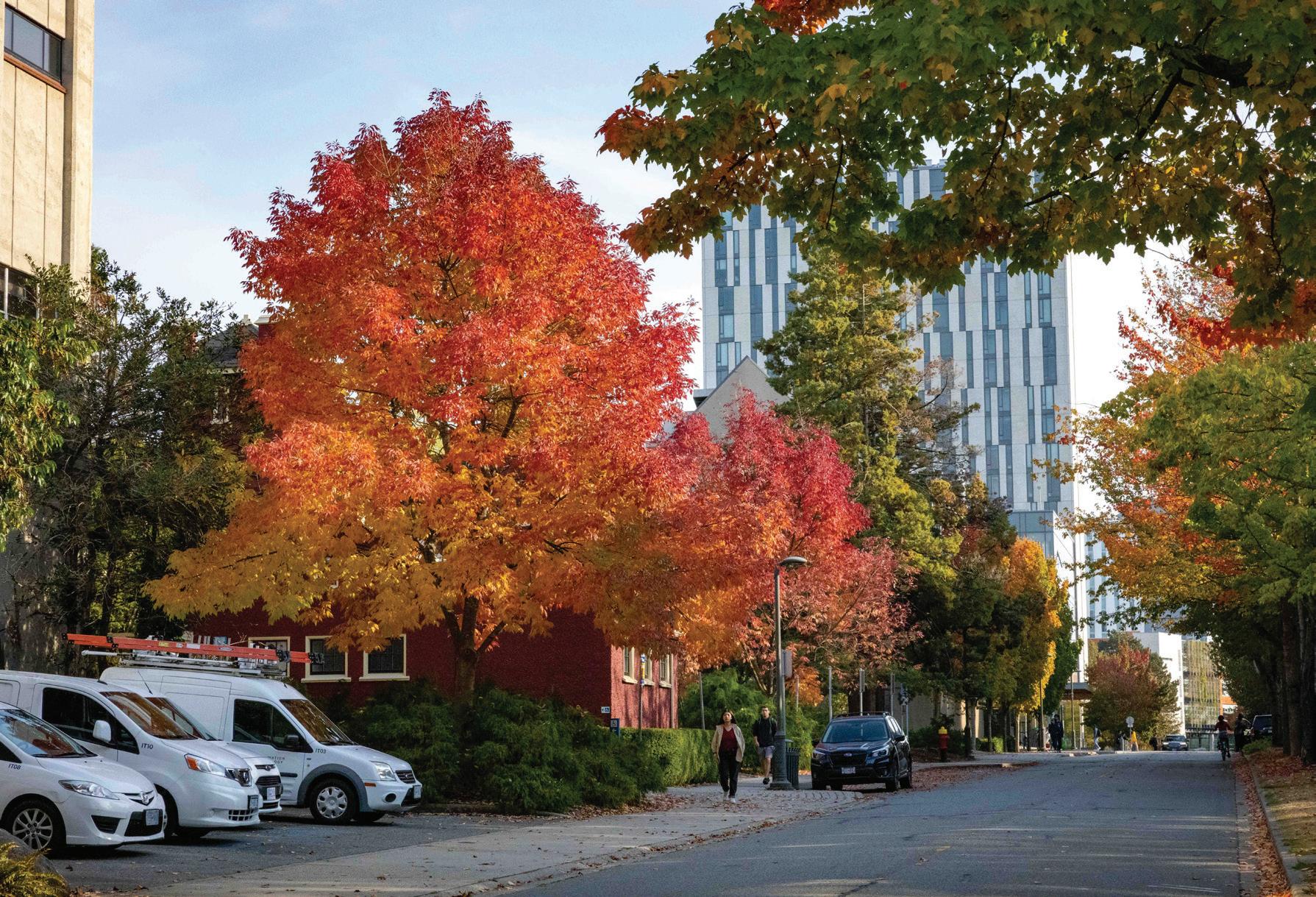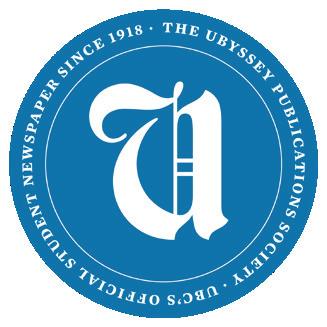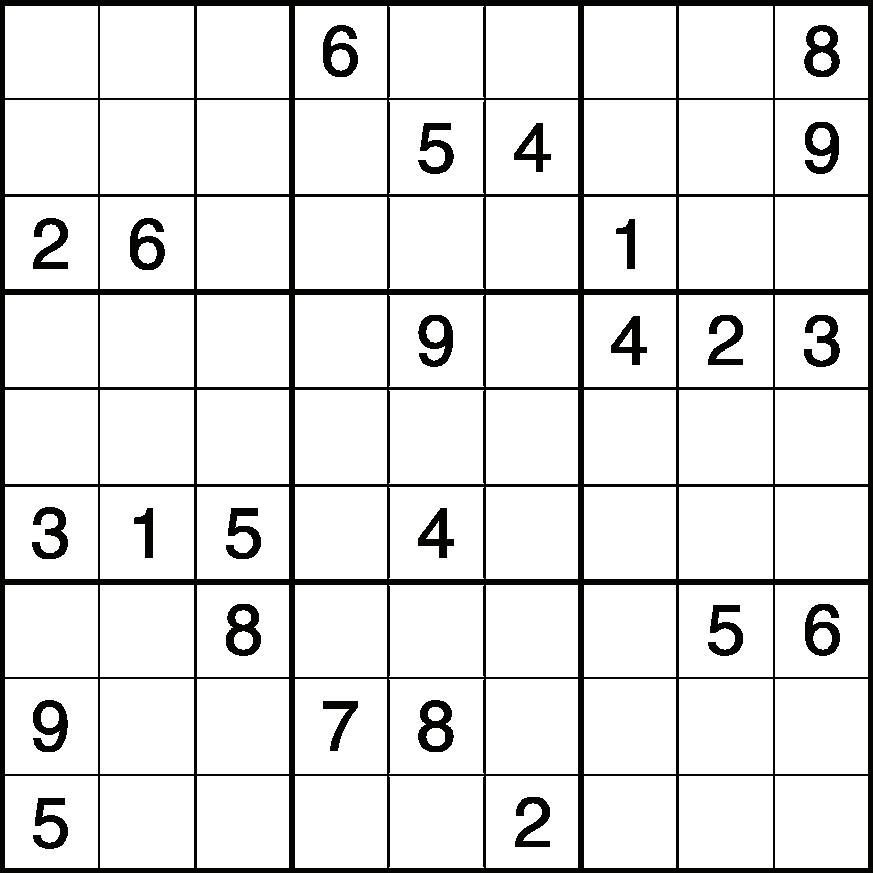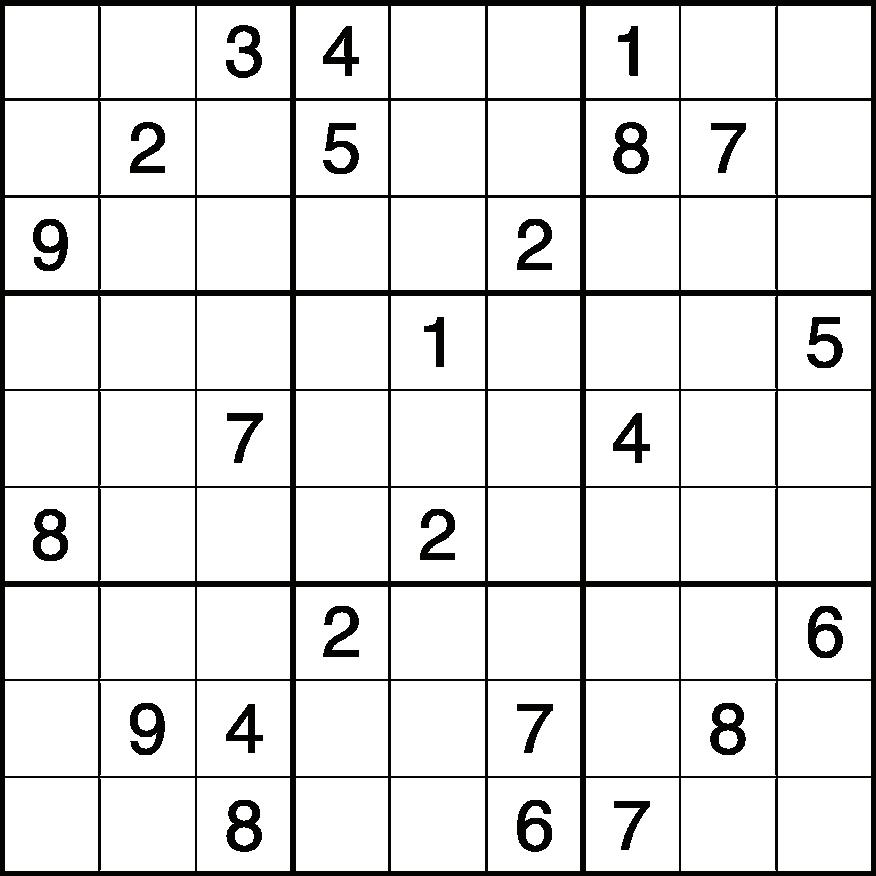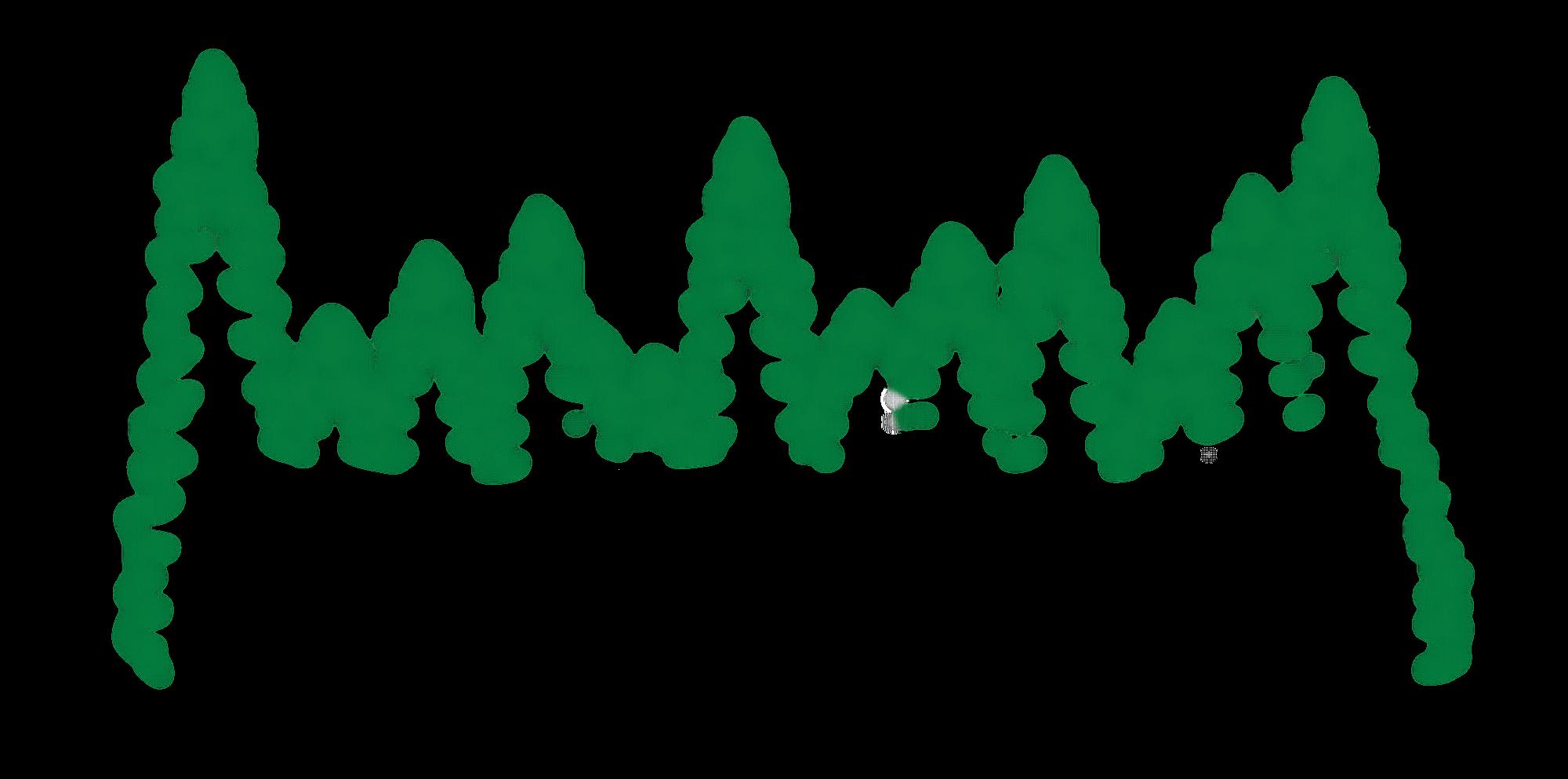
We wish to


We wish to
suitable position (as determined by the opinion editor) to speak on UBC-related matters. Submissions must not contain
1.
2.
3.
Elena Massing ContributorEveryone has experienced the panic of scouring the Internet for a last-minute gift during the hol iday season — furiously scrolling through Amazon until finally, you find something just right for that special someone. You put the item in your basket, and realize there’s no way that it will arrive before your family Christmas gathering tomorrow. Now what?
The average person would settle for a nice scented candle or a box of chocolates. Instead, last Christmas, computer science and master’s of management student Sophie Berger got to work. With in six hours she created Local, a chrome extension that locates Amazon products in stores in your area.
“During the pandemic, everybody got so comfortable just going on Amazon, ordering things, and getting them shipped to [them], because [they] didn’t want to leave [their] apartment and go to stores. Now, since the pandemic is slowly shifting back to normal, there are a lot of peo ple that are trying to find these local alternatives again, and I feel like this gives them a tool to do that.”
Berger’s work quickly started to attract international atten tion from marketers and fellow programmers. Since she didn’t come into the project with a business plan, Berger approached her entrepreneurship professor for advice and is currently in the beginning stages of negotiating with potential buyers to establish Local as a full-fledged business.
Local is Berger’s most recent endeavour, but it is far from being the only impressive computer programming achievement on her resume. In her teen years, she became a founding engineer
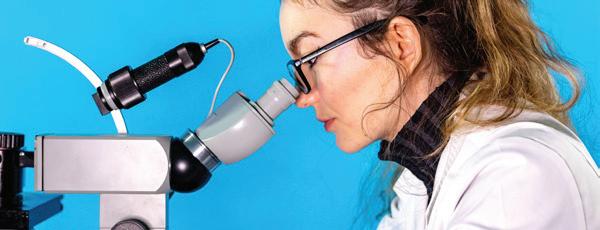
of Mindstep, a UK health startup that created a dementia screening app. As her first major project, it helped her begin to “see all the blood and sweat that goes into [creating a startup], and learn about both the technical side and the business side.”
“Of all my personal projects that I’ve done,” Berger said excit edly, “I always feel that the ones related to artificial intelligence and that space are the most fun. It’s cool to see a computer do stuff by itself.”
This is why she loves to par ticipate in hackathons, comput er programming competitions. Her favourite program that she created at one of these events was a physiotherapy tool that could measure the angles of a person’s limbs, then tell them whether or not they were doing the exercise correctly.
It is out of pure coincidence that much of Berger’s work has been related to health care, but she has come to realize that it genuinely is an area of interest for her.
“At one of the hackathons, I worked with a former UBC student that did his undergrad in pharmaceutical sciences. We developed an app that would let you, using near-field communica tion technology, tag prescription bottles and it would read out to you when and how you should take them. We ended up entering a competition with Microsoft and got pretty far in that,” Berger said.
Starting in grade nine, Berger knew she wanted to work with computers. She always enjoyed the creativity in programming. But above all, Berger finds herself most drawn to the entrepre neurial aspects, along with the freedom programming gives her to pursue passion projects.

“I [saw my parents] always complain about their work, and
how they’re having a bad day … I thought that I don’t really want to be in that same position, of being in a job and not really enjoying it and just staying there for whatever reason,” said Berger. “That’s how the idea of entrepre neurship and working on these side projects really started for me. I wanted to take something that I was passionate about, an idea I believed in and turn that into my work.”
Although Berger grew up in Austria, she was drawn to Vancouver and UBC by the re sources the university provides for programmers. She loves her home country, but since it lacks “space for entrepreneurship and innovation,” she emphasizes how grateful she is to be at a school with more support and opportu nities for advancement.
In just a few months, Berger will begin working for LinkedIn as a software engineer, following a summer internship with the company. She will move to San Francisco for the job, which she describes as scary, exciting and “a logistical nightmare.” Though she has never been to the city before, she already has a suspicion that she will be returning to Vancou ver at some point in the future, since she has fallen in love with its possibilities for outdoor explo ration — a key aspect of how she maintains some peace of mind in her busy life. However, she recognizes that her transition to a new city is a prime opportunity to “just get out and see what’s out there.”
Going into this new stage of life, she holds tightly to a princi ple which has helped guide her to success: “Stick with your idea, and know why you want to stick with it … because that’s what’s going to allow you to tell other people why you’re passionate and get them onto your side.” U
UBC’s Board of Governors ap pointed Dr. Deborah Buszard as UBC’s interim president.
Board Chair Nancy McKenzie announced Buszard’s appoint ment in a broadcast message on October 3. Buszard will take over from six-year President Santa Ono on October 14. Buszard was the deputy vice-chancellor and principal of UBC Okanagan from 2012 to 2020. Buszard will hold the role temporarily until the board appoints a permanent re placement. McKenzie’s statement did not give a timeline for the permanent search process.
Lawrence Liu was elected AMS VP finance on September 29 in a by-election. Liu — who previously served as the associate vice-pres ident funds in the AMS VP Finance Office — beat out AMS Strategy and Governance Lead Kamil Kanji and the Arts Student Centre (represented by Mathew Ho). Liu ran on a platform of increasing mental health coverage under the AMS/GSS Health & Dental Plan, opening a new food outlet in the Nest and expanding financial aid and support for stu dents. When asked what his first priority would be as VP finance, Liu said, “Let’s fix this deficit.”

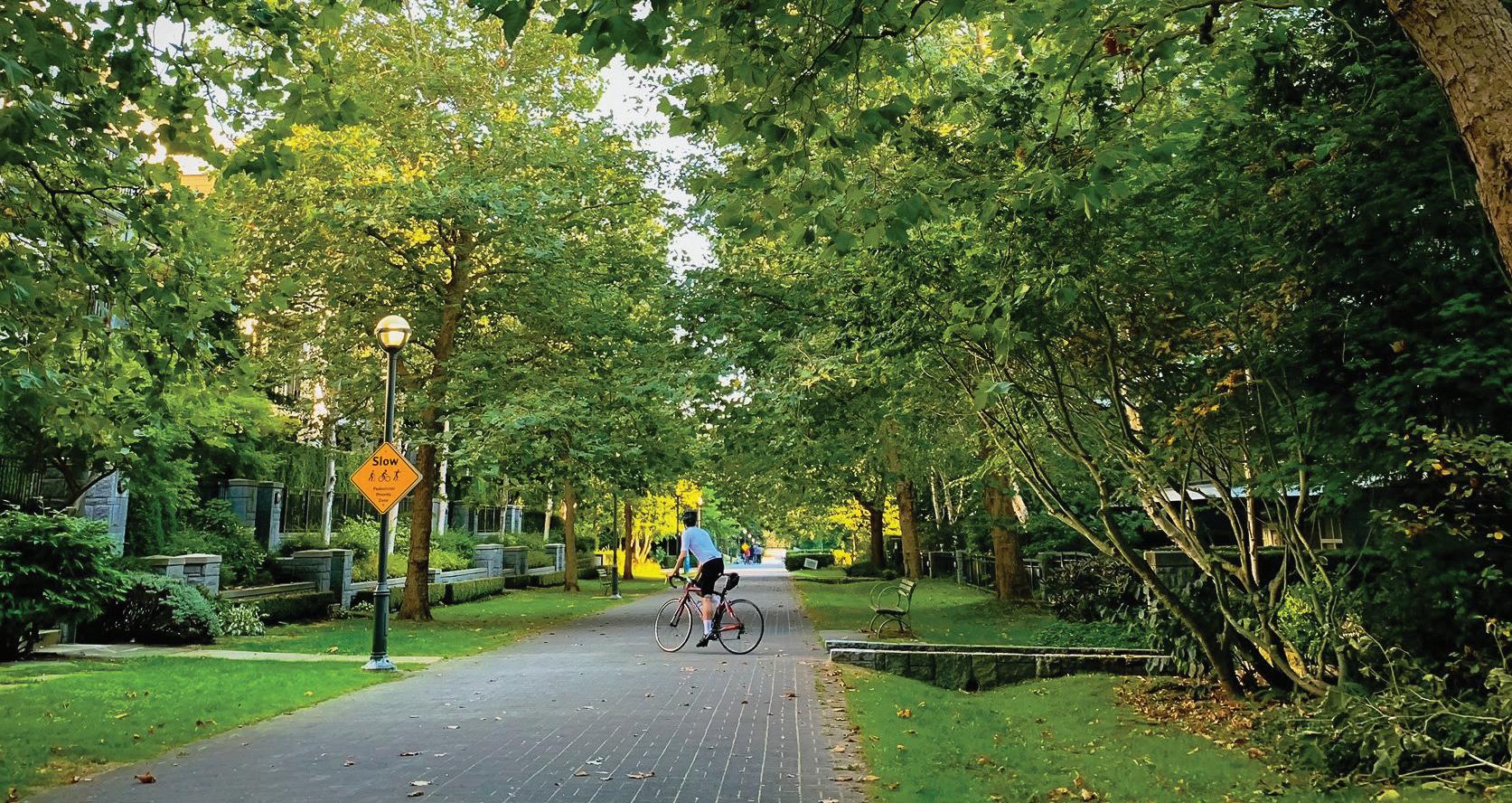
At the September 26 Board of Governors meeting, President Santa Ono announced $500,000 for food initiatives, but how this money will be spent is unclear. In a statement sent to The Ubyssey, Mathew Ramsey, director of uni versity affairs at UBC Media Re lations, said the $500,000 is set to be a one-time occurrence, drawn from the President’s Priority Fund, and be split among the Van couver and Okanagan campuses. The announcement comes as bud gets for food initiatives have been slashed, resulting in affordable food outlets like Fooood to shut down and others like Sprouts hav ing to scramble for more funds. Students have criticized one-time food security funding, saying it does not appropriately address the systemic issue.
Students criticize UBC’s response to Queen’s death
Students at the School of Social Work are calling UBC’s com mitment to reconciliation and decolonization into question after they did not receive a response from the President’s Office on an open letter published on Septem ber 16 critical of the university’s statements on the mourning of Queen Elizabeth II. Sheryl Lightfoot, senior advisor to the president on Indigenous affairs at UBC told The Ubyssey that she could not comment on the lack of response to the letter, but that the statement was not meant to conflict with UBC’s commitment to reconciliation. U
As the current term of the direc tor of Electoral Area A comes to a close, two candidates are vying for the position in the upcoming general local elections.
Electoral Area A is an unincor porated region of Metro Vancou ver encompassing UBC, the Uni versity Endowment Lands, the area along Howe Sound between the District of West Vancouver and Squamish-Lillooet Regional District and a few islands in the Vancouver area.
The director is Electoral Area A resident’s elected representa tive at the regional level and is a member of the Metro Vancouver Board of Directors. The director also sits on the Mayor’s Coun cil on Regional Transportation which supervises TransLink.
The election is on October 15.
Residents can find more voting information on Metro Vancou ver’s website.
Jen McCutcheon is the incum bent director of Electoral Area A.
In an interview with The Ubyssey,
McCutcheon said that while the role may not have much direct decision making power, she she wants to be a part of the solution on big issues for residents like climate change and affordability.
“I really see my role as a strong advocate for residents and com munity members out on the UBC Peninsula,” said McCutcheon. McCutcheon said something
she was most proud of in her past term was increasing community participation and communication.
Jonah Gonzales is running as Progress Vancouver’s candidate in Electoral Area A. He works as data and intake coordinator in the department of education,
employment and training for Squamish Nation and is a student at Capilano University. Gonzales is also a member of the Squamish Nation. Gonzales supports the expansion of the SkyTrain to UBC and believes in partnering with First Nations to build housing.
The Ubyssey did not hear back from Gonzales after multiple requests for comment. U
disorder when she lived in first-year residence.
When Hong used the meal plan, she had mixed feelings about the readily available nutritional infor mation, but appreciated that she could make informed decisions.
“Sometimes, seeing those calories, it would scare me into not wanting to eat there. But other times when I did want to eat there, it was nice seeing that nutritional info,” she said. “It gave me a sense of relief almost.”
Hong worried that removing ac cess to information may discourage students from eating.
This article contains mentions of eating disorders.
UBC recently removed nutritional and caloric information from signs and digital platforms in first-year residence dining rooms.
In the past, residence dining rooms displayed caloric infor mation at food serving stations. This information could also be found on Nutrislice, a web-based platform where students can view daily menus for all first-year dining locations, as well as certain other food outlets on campus. As of this year, this information is no longer accessible — although ingredient lists and allergen information are still available.
Colin Moore, director of food services at UBC, said it was import ant to look at the bigger picture of
residence dining rather than focus ing on the removal of nutritional information, which is only one aspect of the greater shift toward an all-access meal plan.
Gloria Sun, manager of nutrition and wellbeing at UBC and the in-house dietitian for first-year residences, said the broader goal of removing nutritional information was to help students “improve their relationship with food in the body and in the mind.”
Sun said one important reason for removing nutritional informa tion in particular was that nutri tional labeling can be inaccurate. The Canadian Food Inspection Agency has a 20 per cent margin of error for nutritional labels, she said. Moreover, terms like calories, carbohydrates and sugars can be misleading.
“You might have heard of the term like eating that 2,000 calorie per day kind of diet,” Sun said.
“But it’s important to understand that that 2,000 calories is based on self-reported data and not really actual energy needs.”
Andy Bains, a graduate student in the dietetics program at UBC, agreed. He pointed out that nu tritional information can be very inaccurate — especially when calcu lating for individual portions which can vary in size.
Labelling can also generate a restrictive mentality toward food, Sun said. This restrictive mentality, according to Sun, leads to dieting behaviour, which can contribute to the development of an eating disorder.
Eating disorders have the highest mortality rate of any mental illness in Canada, and nutritional information can be triggering for those with eating disorders.
Bernice Hong, a third-year student in the dietetics program, was recovering from an eating
“I’m not going to speak on behalf of those with eating disorders, obviously, but I do think that some people might choose to not eat in stead of eating something that they don’t know the nutrition [informa tion] about.”
Several community members have also expressed concerns in online forums with not being able to access nutritional information.
Sun responded to the concerns by saying that students could access the on-campus dietitian for more serious concerns and work together to create a plan for their own nutri tion and well-being.
Sun said, the change could pro mote intuitive eating.
“[Intuitive eating] is focusing on internal factors, like listening to what our body needs,” she said.
Bains agreed that the change promoted intuitive eating, and said it was important to keep in mind that dining halls are often students first exposure to choosing food entirely on their own.
“After students leave this dining hall, what are they leaving with when it comes to dietary habits?” U
This article contains mention of residential schools and sexual and physical abuse.
On Friday, September 30, commu nity members gathered at UBC for the second annual Intergenerational March to commemorate National Day for Truth and Reconciliation and show support for residential school and intergenerational sur vivors.
The Intergenerational March, organized by the Faculty of Land and Food Systems (LFS) and the Faculty of Applied Science, began at the Indian Residential School History and Dialogue Centre. There, Musqueam Elder Doris Fox wel comed participants to the tradition al, unceded and ancestral territory of the Musqueam people.
“I want you to know how good it makes my heart feel to see all these orange shirts. It means a lot to a lot of us,” she said.
Fox then invited those present, including many families, to take a moment to imagine the heartbreak First Nations parents suffered when their children were taken to resi dential school.
“Imagine how you would feel if it was your niece or nephew, your child, your granddaughters, your grandchildren. How would that feel?”
Stalqayu (Coastal Wolf Pack), danced and sang several songs, in cluding a warrior song dedicated to the survivors of residential schools.
of my friend getting beat up come back up.”
“I’m a husband, I’m a father, I’m a grandfather, and just recently, my great-granddaughter is going to be two this year. That’s the success in my life. That’s my pride,” he said at the end of his speech. “One of the things that the government and the church tried to do is destroy our human values … And they didn’t succeed.”
This was the second year Applied Sciences and LFS hosted a march for National Day of Truth and Reconciliation – formerly known as Orange Shirt Day.
“Every day we have to be brave or feel like survivors but today we can let our guard down,” said march attendee and first-year medical student Denna Flett.
“I think [National Day for Truth and Reconciliation is] about getting together, seeing the community that you have both with other Indigenous people in the region but also with those who are allies and really just coming here to … support one another.”
The march then commenced along Main Mall. Informational placards were placed along the way to educate participants on the significance of the day. Groups of orange-clad attendees stopped to take in each sign.

didn’t really know about residen tial schools that weren’t from the Indigenous community,” said UBC staff member Joe Stevens. “It’s nice to see just so many orange t-shirts … people putting in time and effort to educate themselves.”
Residential School, and the phys ical, verbal and sexual abuse he suffered there as a child.
Jones also spoke about how he lost the ability to speak his language from the residential school system.
Following Fox’s words, the Coast Salish performance group, Tsatsu Jaya Athwal Contributor
UBC’s Wellness Mentors Pro gram, a pilot program aimed at supporting IBPOC students, has ended.
As part of the program, which ran from September 2021 to April 2022, IBPOC students had the chance to connect with fellow IBPOC students, or Wellness Mentors, and have conversations about shared experiences and ideas. The program will no longer be running in its piloted form, but UBC says it is still committed to supporting IBPOC’s mental health through various other programs.
Levonne Abshire, director of health equity, promotion and ed ucation at UBC, said the program was created to address gaps high lighted early in the COVID-19 pandemic surrounding racism and alongside goals to support the IBPOC community at UBC.
“The movement around an ti-racism [pushed us] to connect with students about what those needs are as it comes to health equity practices and programs and services,” Abshire said.
Abshire said her unit con sulted with various student groups, including “affinity-based student groups that do identify as IBPOC.” She said they learned “there was a desire to have more specific programming that was more targeted.”
“When I was young, people Abshire stressed the ending of this program does not mean UBC is ending support specifically for IBPOC individuals.
In a follow-up statement to The Ubyssey , Student Health and Wellbeing said the Wellness Centre learned how to better sup port IBPOC student health and wellbeing based on data collected from the pilot program.
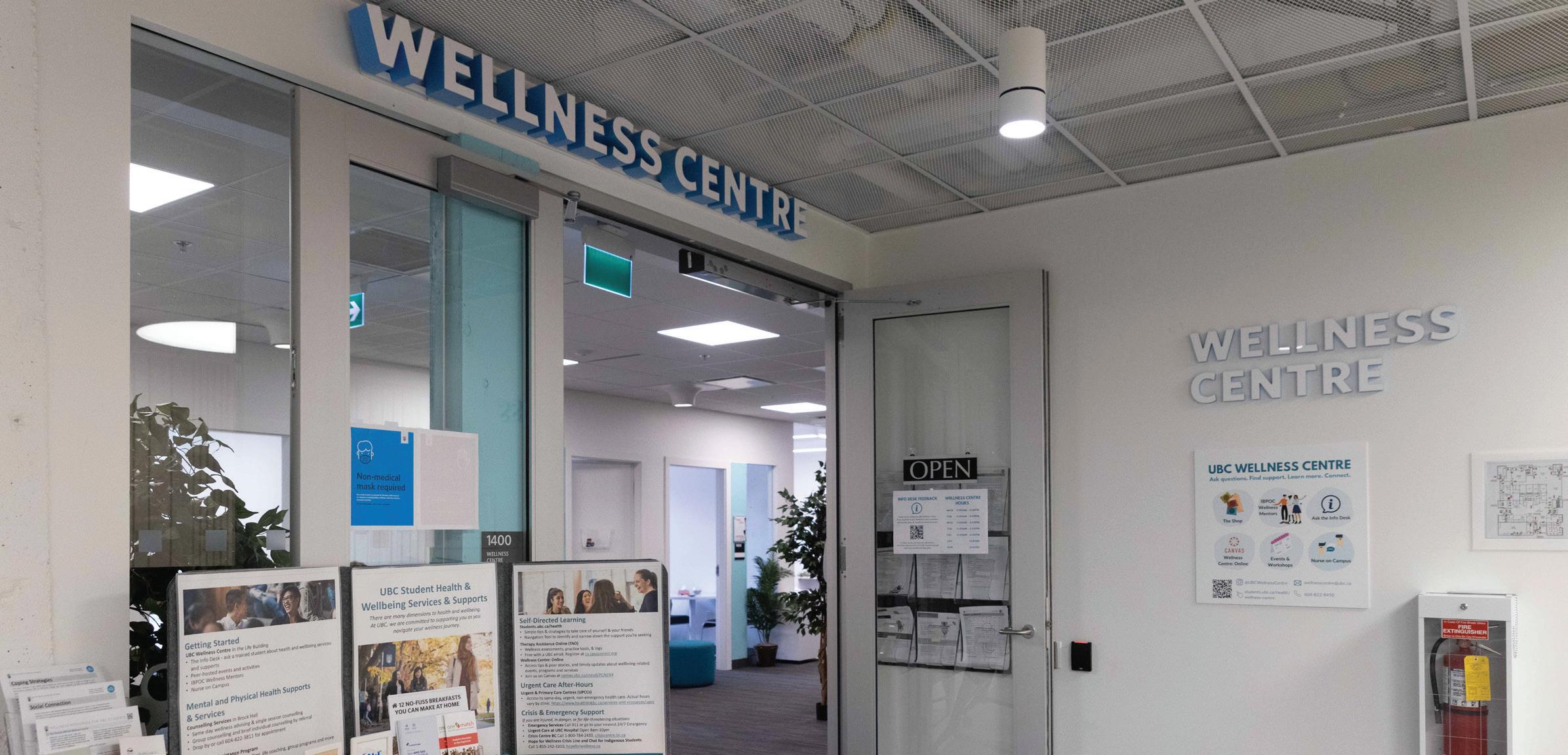
“Although the IBPOC Wellness Mentor Program will not be
The march concluded at the Reconciliation Pole, where Snuneymuxw First Nation Elder John Jones shared his harrowing personal experience at the Alberni offered in its piloted form, UBC Student Health and Wellbeing is committed to supporting IBPOC student health and wellbeing,” it read.
“I promised myself back then as a child, at seven years old, that I’m not going to learn any more of my traditional language,” he said. “Ev ery time I try and think about trying to speak my language, memories Society and Graduate Pathways to Success to facilitate programs and events for IBPOC students.
Organizers provided support to participants, including on-site counselors and support dogs from the Pacific Assistance Dog Society (PADS), in recognition that Nation al Day for Truth and Reconciliation can be distressing.
PADS communication manager Tara Doherty noted, “We know that this is a hard day for some folks, and these guys being here just brings a little bit of joy.” U
Abshire talked at length about numerous current initiatives which aim to support the IBPOC community at UBC, including the Beyond Tomorrow Scholars program, and planned partner ships with UBC Sustainability Ambassadors, Graduate Student
AMS Peer Support is a student-run wellness initiative which provides “free, confiden tial, one-on-one peer support for UBC students facing a wide variety of challenges”.
In a written statement Eric Lowe, senior communications and marketing manager with the AMS, wrote “as for Peer
Support, we [do not] have a pro gram specifically for the IBPOC community at this time, but the service supports students of all backgrounds, including IBPOC students.”
Lowe mentioned Peer Support is “currently working on a work shop targeted to the IBPOC com munity.” However, “it is still very much in the planning stages ... we hope to launch the workshop in early 2023.” U
This article contains reference to suicide.
I first realized that Vancou ver-based comedian and UBC alum Ed Hill was something spe cial, nine days before I saw him perform at the Vancouver Fringe Festival, when he told me that his latest show Stupid Ed would end on a sombre note.
I warned him, jokingly, that I’m a notoriously difficult person to enjoy stand-up with; as much as I appreciate good comedic sto rytelling, I don’t laugh easily. His response caught me by surprise.
“I’m not actually going to end on a laugh. I’m ending on a ‘no laugh,’” he told me. “I’ve realized that life doesn’t end on a laugh. Life kind of just carries on to the next moment, so I want to parallel that as much as I can.”
Stupid Ed is a follow-up to Hill’s award-winning special from last year, Candy and Smiley, which derives its title from the names that his parents chose after emi grating to Coquitlam from Taiwan when Hill was ten years old.
Hill has described his previous show as a reflection on his parents and upbringing, his attempts to re ject them and ultimately, growing up to understand and accept how
they shaped his life.
Self-acceptance is a running theme in Hill’s work that’s given special emphasis in Stupid Ed
The show frames this process through spotlighting his rela tionships with the women in his life — namely his wife, mother and grandmother — and how they helped him to come to terms with his identity.
“That’s where I really learned self acceptance. To be who I am,” said Hill. “In order to love others I’m going to have to learn to love myself.”
The title of the show references a comment made by Hill’s father while he and his wife were visiting his parents. While looking through old photo albums, they happened across pictures featuring a teenage Hill in full goth makeup and dress, evidence of what he describes as “me ruining every family vaca tion.”
“My dad kind of walks over and he sees it, and he just goes, ‘Stupid Ed,’ and he walks away,” Hill recounted. “And I realize that’s his acceptance! That’s as much as I’m going to get, and he kind of accepted who I am as a person. And this show is about that. It’s all these different moments in my life that make me who I am.”
True to his word, Hill doesn’t end Stupid Ed with a laugh, but with a sincere and devastating ad
mission about attempting suicide. That almost makes it difficult for me to think of the show as standup comedy.
Allowing himself that level of vulnerability —especially choosing it as a final impression to leave on his audience — is an incredi ble risk. While many comics use personal and painful moments as fodder for their craft, choosing to end a show on that rather than of fering your audience the catharsis of a punchline is comparatively much less common.
None of this to say that Ed Hill isn’t funny. His jokes are good, his pacing and delivery are impecca ble. I found myself laughing at a comedy special for the first time in a long while.
However, the strength of his performance doesn’t lie in one-lin ers, but in the parts that hurt a little, or hit slightly too close to home. The key theme of Stupid Ed is self-acceptance, and as funny as it can be at times, the show often dwells on Hill’s past feelings of alienation, embarrassment and profound sadness.
It’s in these moments that Hill’s talent and the unique per spectives he brings as a comic are the most apparent and make him stand out amidst a sea of wise cracking commentators trying to eke out a reaction.
The most effective kind of
comedy, in my experience, touch es on things that are deeply per sonal and often very dark. It’s an excellent medium for processing and translating the worst parts of
life into entertainment and can turn what would otherwise be painful into something insightful and amusing. Ed Hill exemplifies that in a way I’ve never seen. U
thought there should be something like this.” Our initial idea was that there was a hole that needed to be filled and clearly there is one, so that was good to see.
I was the kind of guy who would laugh at someone if they went to counselling. I was like, ‘Why would you do that? I can figure everything out on my own.’ And then I got hit hard, over and over, and I actually sought help, and started going to counselling. And it helped.
I didn’t even know about the resources for counselling at the time … I wish someone would have told me earlier. I wanted to be able to provide that for other guys on campus, so I brought that idea to my buddy Alex [Beschea], who’s the other co-president. We felt like if we can be leaders, and show that we seek help, then more guys will follow.
What kind of events is MMHC looking to hold?
The UBC Men’s Mental Health Club (MMHC) formed officially this past summer, by a group of friends with the goal of encourag ing open discussion and support for men to combat a toxic culture of silence.


They held their first event in June, taking a dip into the waters at Wreck Beach to kick off men’s mental health month.
We sat down with co-presi dent Pierre Kahwaji, a third-year biology student, to talk about mental health and building a cul ture of asking for help.

This interview has been edited for length and clarity.
What we want to do is form a community of men on campus that support each other through
[non-judgemental] open discus sion. Even with ourselves and in our own friend groups there isn’t that give and take, where you can really open up about something you’ve been going through. We want to start that conversation.
How did your booth at Imagine Day go?
We had over a hundred people put their email in our mailing list. Some people were saying, “Oh, I always
We took a dip for men’s mental health in the summer, which was a sober event. One of the core val ues of our club are sober events — we want to show that, okay, sure, going out to a club, drinking, all that’s fun, but how fun was your night if you can’t even remember it the next day? We want to show that you can have fun and meet people and do all that stuff sober. We also want to run fundraisers for mental health associations. In
November, we’re planning to run a Movember campaign, trying to get a huge group of guys to grow out their mustaches.
Yeah, we get that question a lot. We only have one event we’re planning that’s exclusively for men. We call it our Open Up event. We would book a room in the Nest and form small discus sion groups where we’ll pose questions. We’ll start it with fun, silly icebreaker questions to get people laughing, and then we’ll throw in some serious questions to get people thinking.
For that event, we’re going to start it off as exclusively for men because we feel like they will be more comfortable that way. But everything else is fully open: our social events, fundraisers, all of that is open to everyone.
When I was young people called me Cheupe Dawa — Swahili for ‘white pills.’ It never bothered me, for it was meant to be a compliment on my light complexion. Growing up in a Tan zanian society plagued with colourism, I was blind to it. I never saw what was staring me in the face: the toxic urge to resemble whiteness, rather than appreci ating my Blackness.
Being ‘Cheupe Dawa’ meant that I had some privileges. I could afford to wear bold red lipstick— almost encour aged to actually— because it accentuated my features and suited me. My sister, however, whose skin glistening rich with melanin, never put on red lipstick — I doubt she ever even considered it because society dictated that it wasn’t created for her to wear. The audacity of denying red to anyone! The same shade that runs in all our bodies was instead only to be reserved for a few. How heart breaking for choices to be dictated and for wants and desires to be disregarded. I wonder now how she must have felt.
I had never experienced living in a society without the undecorated sense of my Blackness. The thought had never even crossed my mind. After all, I was ‘Cheupe Dawa,’ the girl who was regard ed like white medicine — until, of course, I moved to Canada.
In a city with a 1.2 per cent visible Black or, as I prefer to say, visible African origin, I learned the harsh realities of what it means to be Other, not because of your views or actions, but because of how you look, the pigmentation of your skin, the kinky texture of your hair, things you have no control over yet they define who you are, who you should be, how you are expected to be, or rather how the world expects you to present yourself as you navigate this thing called life.
It was after nine months in Canada when, in a group exercise, we had to fill out an individual identity wheel and there it was — a slice of the cone on the edge of the huge circle, taunting me with the question: “Ethnicity, Race, Nation ality?”
It took up a small section of the circle compared to what it should have; in my opinion, it should have been at the very centre. From where I was in this particular country, existing in this continent, race defined my identity. It defined all the other cones in the circle, from education to social groups to even sexual orientation.
Filling out the identity wheel, I put down, Black/African/Tanzanian/Cha gga. Had I been asked to fill the wheel while in my home country, Tanzania, my straight answer about my ethnicity would be Chagga, my ethnic group, a people from the slopes of Mount Kili manjaro, with a shared history, language and practices. There was and is a com monality in what it means to be Chagga — a uniting factor.
Being Black, on the other hand, the commonality is harder to find. It’s not like all Black people speak the same language — “the Black language” — or have the same culture or norms. No, the only thing that unites Black people is the pigmentation of our skin, that is, what makes us identifiable by others who are of a different race.

However, among ourselves, I have come to discover my own definitions of what it truly means to be Black in a western country.
To be Black is to exchange acknowl edging nods with other Black people as you walk down the street, a greeting that surpasses acknowledgment, that says, “I see you my brother/sister, and in case anything were to happen right now I got you.” That is what those pleasant nods with strangers-turned-family in the middle of the streets mean to me.
It is to walk down streets, roads, rooms and buildings and notice there is no one remotely resembling you, and not just in racial view but in your experienc es.
It is walking or sitting in buses alone with no one next to you and having to force your mind not to wonder, Are people purposely not sitting next to me or am I exaggerating things?
To be a Black woman is to endure and smile when asked, “Is that your hair?”
“Did you cut your hair?” or even, “Are you going to go out with your hair looking like that?” when it is at its God-ordained state. It is knowing that, because your
hair defies gravity, it may intrigue or intimidate people. It is having to endure the stares of strangers while doing the most basic things, like walking down the street with hair combed and dried up.
It is being calm when offended while expected not to be offended because then you are being sensitive or even worse, an ‘angry Black woman’ — and no Black woman wants to be labeled as the angry Black woman.
Meanwhile being Black, a woman and a student brings another definition. The added pressures of your race and gender are still present, and yet you are also expected to perform as a scholar. It means having questions that have to do with race, why it matters or doesn’t mat ter, and wanting to ask them but instead feeling like you have to be quiet because women are supposed to be quiet and at the same time a glance around your lec ture room reveals you are the only Black person there, so now you feel as though you ought to say something because you have to represent other Black folks, and you cannot possibly be the quiet Black student who never says a thing, can you?
Being a Black woman scholar navigating the world is to be paralyzed with indecision between who you are supposed to be and who you are. It is to feel the expectation to “be yourself” and yet there is a roadmap — or rather, many contradicting roadmaps — of how you should behave.
Being an African woman from a colonized country and choosing to move to the West is recognizing that at home you will face colourism and while abroad you will face racism. Neither is
Words By : Madeline Kenja IllustratIon By : Zoe Wagnerbetter than the other, no lesser evil, one devil applied by your own people and the other applied by the people who sold the first devil to your people.
Accepting this reality is hard but it is through accepting this that I can truly navigate life as my true self and not as what others impose on me.
With these experiences, I have come to learn that for people — white, black, brown or pink — to truly empathize with one another about the social constructs that make our world go round, we need to be able to com municate our experiences. But alas, communication without comprehension is nothing; we need to feel each other’s wounds and share the pain.

I can imagine what white privilege is because I have been on the receiving end of unearned praise in a colourist society.
I also know what being Black is, having countless debates in my mind of whether to speak up or shut up because, on one hand, I don’t want to be “that Black person,” but on the flip side, as the African-American quote goes, “my ancestors walked so that I could run.” Or in my case, my ancestors were colonized and robbed of their land and possessions — not for me to stay silent and watch as it continues to happen decades later.
As individuals, we are called upon to do more and be better. U

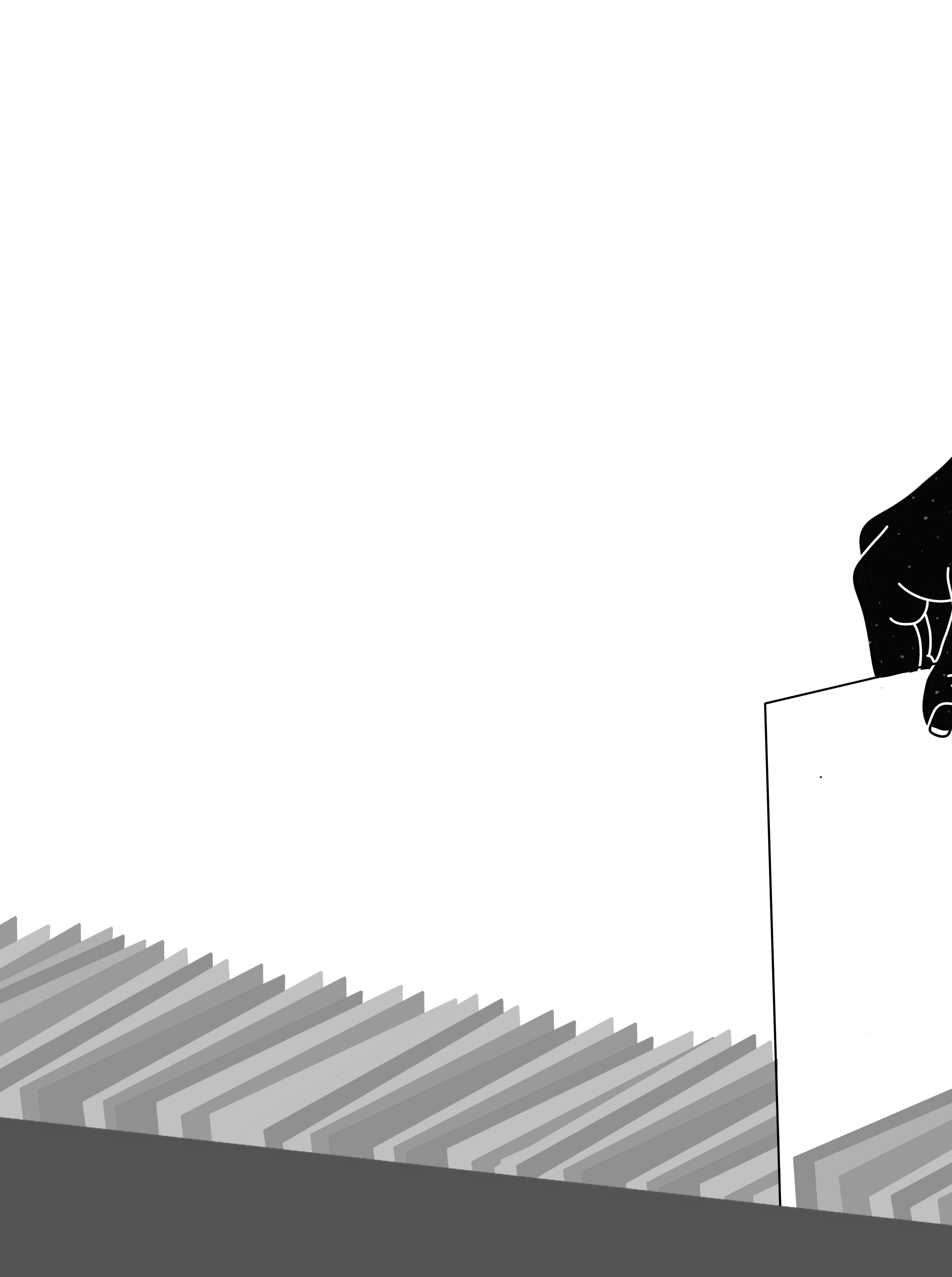
This article contains mentions of sexual assault.
“Y-O-U-N-G at UBC, we like ‘em young. Y is for ‘your sister.’ O is for ‘oh, so tight’. U is for ‘underage.’ N is for ‘no consent.’ G is for ‘go to jail.’”
In 2013, students yelled this chant on a bus ride during frosh week. The sound of the words travelled through the bus and made its way into major news outlets across the country.
The ‘Sauder rape chant’ became a symbol of sexual misconduct and rape culture in the Sauder School of Business and Commerce Undergraduate Society (CUS) — eventually leading to CUS executives stepping down, CUS leaders undergoing sexual violence prevention training and the cancellation of Sauder frosh events.
Rape culture at Sauder didn’t just disap pear after 2013. In 2017, an anonymous stu dent posted in the UBC subreddit about their experience with “sexual violence by CUS members,” according to the CUS’s Historial Document on sexual violence. In 2020, anon ymous students submitted their experiences regarding sexual violence within the CUS to the UBC Confessions Facebook page.
This led to the creation of Article 13, the CUS’s Sexual Misconduct Mitigation Policy — a constituency-specific policy that builds upon the AMS’s Sexualized Violence Policy (PC2).
Developed in 2019, the AMS’s PC2 — Sexualized Violence Policy, formerly known as I-17, outlines how the student society responds to disclosure of sexual misconduc PC2 defines ‘consent’ as “the informed, enthusiastic, conscious, ongoing, and vol untary agreement to an act or acts and to continue to engage in the act or acts, which is communicated through words or conduct.”
Though PC2 applies to all AMS clubs, members, non-student staff and subsidiaries — including undergraduate societies — some undergraduate societies have established their own sexual assault policies, in addition to the AMS’s PC2 and UBC’s SC17. SC17 is UBC’s sexual assault policy.
The policies aim to fill the gaps that the AMS-wide policy leaves, reflecting the importance placed on sexual assault preven tion on campus — the 2022 AMS Academic Experience Survey reported that one in five UBC students has experienced sexual assault or misconduct during their time at UBC. From the CUS to the EUS, constituencies have found unique ways to develop consent cultures within their own communities and ensure that their constituents are safe on campus.
The start of the CUS’s recent efforts to address sexual misconduct started like many conversations these days do — with a Face book post.
In February 2020, an anonymous student submitted a post to the UBC Confessions Facebook page alleging they knew someone who reported a sexual assault to the CUS, but the undergraduate society didn’t do anything about it.
Over the next month, more anonymous posts expressed similar experiences on the Facebook page.
According to fifth-year entrepreneurship and organizational behaviour student and CUS Equity Advisor Ky Sargeant, “an incident regarding sexual misconduct [that] implicat ed some members of the CUS” led the CUS to create their own sexual misconduct policy.
The CUS’s Sexual Misconduct Mitigation Policy (SMMP) was created within CUS Code in the 2020/21 academic year, according to Sargeant.
SMMP does not specifiy termination as a consequence for sexual misconduct, but Sargeant said it is mentioned in an internal document.
“If you are not upholding the expected behaviour and professionalism and just like pure being an asshole, you’re going to get fired. It says it in much more formal lan guage than that, but that’s the effect,” said Sargeant.
Fifth-year bachelor of fine arts and master of management student Anneke Dresselhuis saw the series of sexual misconduct allega tions on the UBC Confessions Facebook page
in 2020 and thought something needed to be done about consent culture in the CUS.
This led her to become the director of CUS Clarify, the undergraduate society’s sexual violence prevention office, with the support of other Sauder students. Before Clarify, the CUS had a sexual violence pre vention student coordinator and service, but Dresselhuis and Evelyn Ashworth (the other Clarify director) thought a dedicated sexual violence prevention group in the CUS was needed.
“Sexual violence is something [that has] unfortunately been a part of my own experience at UBC,” said Dresselhuis. “I ultimately got involved in Clarify in the Commerce Undergraduate Society because I was really feeling exhausted hearing about the sexualized and gender-based violence that was disproportionately being experienced by Queer folks and women around me, specifically in the Sauder School of Business.”
The creation of the SMMP was split between the CUS president, CUS’s equity portfolio and Clarify. Kristian Oppenheim, a recent Sauder grad and former CUS pres ident said UBC Sexual Violence Prevention Resource Office (SVPRO) was “really great mentors and advisors” in the development of the SMMP.
The SMMP says CUS event planners must undergo at least one sexual violence prevention training workshop — facilitated by either the SVPRO, AMS Sexual Assault Support Centre (SASC), UBC Investiga tions Office or another party approved by the CUS executive.
According to Sargeant, CUS executives have to complete a mandatory SVPRO Canvas module, but are not subject to completing other sexual violence preven tion training if they are not involved in event planning, as per the SMMP. She said there have not been reported incidents of sexual misconduct since the creation of the policy, but confirmed there is no formal disclosure process when reporting sexual misconduct to the CUS.
“I think that’s definitely something that we still need to work on in terms of building up a robust policy for disclosure,” said Sargeant. “The wider Sauder [com munity] is also working on a lot of these re porting processes and grievance processes. I happen to work with the Dean’s Office
and so I know that the Dean’s Office right now is creating a really robust reporting strategy, so that students can report there.”
When asked if AMS’s Sexualized Violence Policy (PC2) — a policy that extends to all undergraduate societies — is enough on campus, Sargeant said it is if students read the policy.
“If anyone read the AMS policy within Sauder or within any faculty in the school, then it would be more than enough,” said Sargeant. “But people don’t.”
“The fact that we have our poli cy and the AMS has their policy, the chances of someone reading one of those two is higher.”

The Arts Undergraduate Society (AUS) represents 13,000 students and is run by president and fourth-year honours political science student Fatima Rua.
The AUS doesn’t have a standalone sexual misconduct policy, but Rua said
it has a “zero tolerance for sexual vio lence … bullying and harassment.”
Hired AUS members, like directors and coordinators, must complete a Canvas module about the AUS called “AUS 101: Getting Started with the AUS,” which includes sexual violence harassment prevention training. These modules were created during the 2020/21 academic year.
AUS executives have access to an “HR strategy” created by Rua in the 2021/22 academic year and are ex pected to follow AUS code. AUS code outlines that volunteers, including executives, can be terminated for “ha rassment of any kind.”
The AUS also holds sexual violence prevention training within its bi-annu al orientation. According to Rua, the AUS invites either the SVPRO or SASC to facilitate a mandatory workshop about sexual harassment and consent for all executives and volunteers.
The Science Undergraduate Society (SUS) has had an internal harassment policy since November 2020, according to fifth-year integrative science and former SUS VP external Keanna Yu.
According to Yu, the policy was created by the SUS human resourc es team after she promised to create better disclosure training as part of her platform. The policy went through SUS Council before being finalized, said Yu in an interview with The Ubyssey in May.
“Consent culture is just going to directly affect how people view us, how people engage with us, especially our volunteers,” said Yu. “And so without that standardized policy there, I think that we were just worried that people wouldn’t really know how to handle conflict.”
Dayle Balmes, fifth-year integrat ed sciences student and former SUS president said in an interview with The Ubyssey in May that the SUS Harass ment Policy is internal policy that extends to executives and volunteers.
SUS did not require executives or volunteers to undergo sexual violence prevention training. According to fifthyear honours integrated sciences stu dent and current SUS President Harjot Uppal, SUS executives and volunteers tasked with organizing events receive training from SVPRO.
Balmes said the SUS Harassment Policy has not yet been used for an incident of sexual misconduct.
The policy defines harassment as “any physical or verbal behaviour that is unwelcome and/or has a negative impact towards an individual/group.” Harassment under the policy extends to sexual harrassment.
The policy also outlines how the undergraduate society responds to disclosures.
After a disclosure is made, a warn ing will be issued for a respondent’s first occurrence of harassment and a SUS human resources team member will meet with the respondent to speak about the “expectations and values involved with being a SUS Staff,” ac cording to the SUS Harassment Policy. Respondents will also create a “plan of action” with the SUS human resourc es team to “rectify the situation, in the spirit of promoting growth and change.”
If another disclosure occurs for the same respondent, regardless of the type of harassment, “a serious conver sation” with the Respondent will take place. Respondents who don’t change there behaviour can be terminated.
SUS did not consult the SVPRO or SASC while writing its harassment policy.
According to fourth-year geological engineering student and EUS Presi dent, Christian ‘CK’ Kyle, addressing harassment has been in the EUS’s policy manual since the 1960s.
But a harassment policy that codifies informal practices wasn’t created until concerned student Jessica Yamamoto, a recent chemical and biological engineering graduate, asked EUS Council if she could help rewrite the current harassment clause in EUS code.
The EUS’s harassment policy is a clause in the society’s policy manual and applies to executives, volunteers and engineering students not employed by the EUS.
The policy outlines that EUS exec utives and volunteers must “immedi ately report the [harassment] incident to the President and the AMS Ombud sperson.” This is a clause that Kyle wants the policy rewrite to address.
“I think one of the biggest issues with the standing policy is the immedi ate reporting that has to happen,” said Kyle. Kyle said he would like to see a policy that gives survivors the choice of if they want to pursue a complaint with the undergraduate society.
Any misconduct perpetrated by an EUS executive or volunteer leads to a vote for termination in EUS Council. According to Kyle, misconduct can include failure to report harassment to the EUS president and AMS ombud sperson, “especially and explicitly if the person who reported it to them wanted something to be done within the EUS.”
Kyle said EUS executives are man dated to receive professional develop ment training, which in the past has in cluded an SVPRO workshop. However, executives are not required to undergo training outside of the professional development.
Other volunteers do not have to
participate in sexual violence preven tion training as well, but the members of the student life committee are required to attend SVPRO workshops since they organize the EUS’s parties.
Engineering parties are run by the EUS and take place in the Engineering Students Centre. For parties, the EUS obtains special event permits from the RCMP, approval from the faculty and hires security, harm reduction and first-aid groups. Kyle also said half of the executive team must be sober during a party.
“During COVID[-19], we saw a lot of institutional knowledge fizzle out,” said Kyle. “I think that helped me real ize that [policy] is something that we can’t afford to lose.”
The AMS is currently reviewing PC2 and the revised policy will be approved in the next few months, according to AMS VP Academic and University Affairs Dana Turdy. She said the policy review will have plain language sum maries to reduce jargon in the policy to make it more accessible to students.
“I think that is really on us to be better with outreach and education re garding the policies,” said Turdy. “One of the main pieces of feedback that we received were that people don’t know that this exists.”
Students can disclose sexual mis conduct to an AMS executive regard less of if they decide to submit an offi cial report. If a student reports sexual misconduct to the AMS, an investiga tion can take place. Based on the find ings of an investigation, respondents can face termination. Students can also report sexual misconduct to UBC.
Turdy said the AMS reached out to the UBC ombudsperson, SVPRO, SASC and others while creating this policy.
When it comes to sexual violence prevention training for AMS execu tives, Turdy said training differs by the year, and it is up to the executives and the student society’s “relationships with the SASC to make sure that this training happens.”
Turdy said she believes sexual vio lence and harm on campus occur in the contexts of gender-based violence and violence against the 2SLGBTQ+ and Indigenous communities.
Student groups like undergraduate societies aren’t required to have sexual violence prevention policies. But Turdy doesn’t think it’s a bad thing to have more policies in place.
“Students are always subject to SC17 as well and UBCs own policies and procedures,” said Turdy. U
This article has been shortened for print. Read the full article at ubyssey.ca/features/ Evelyn Ashworth contributed to The Ubyssey in 2020. She was not involved in the writing or editing of this piece.
The completely, totally normal Sauder student sitting next to you at Koerner’s has said, “It just really feels like we’re living in a panopti con, you know, like Foucault.”
You’ve started to panic. They’re a philosophy minor. Don’t be afraid. Just follow these 53 easy steps and you’ll get through this conversation with a wannabe centre-of-din ner-party-attention without issue.
First, confirm: You need to be sure this vaguely human-shaped individual is, in fact, a philosophy minor. Ask them something like “What do you think about the meaning of life?” If they respond by asking if you’ve seen Bojack Horse man, I’m sorry.
Second, don’t ask: Though you may want to ask them to explain what they mean, don’t. The person next to you has no idea what they’re saying, and asking them to explain will only lead to a string of meaning less names that will make you feel really... existential?
Does that mean anything?
Third, try to understand: Maybe this could actually be an interesting conversation!
My editor is holding me at gunpoint asking me not to accuse all philosophy minors of being horrible people. Someone help! I think she might be a philosophy minor.
Yeah! Maybe you could learn some really cool philosophy! It might be regurgitated from a video
essay about Rick and Morty and remind you of what it was like to be 14 years old, but it’s probably philosophy.
Fourth, spew: Remember that time your high school English teacher went on a semi-racist tangent about Buddhism for half an hour? Great. You may be concerned about saying things you neither mean nor remember at all. Don’t be. Nothing you say in this specific
moment matters, so just let Mr. Danbury speak through you.
You may find yourself slipping into a frightening self-assured ness. Don’t worry! Your misplaced feelings of superiority may convince the philosophy minor you’re a really smart person and they may respect you enough to stop talking for five seconds. It’s not much, but it’s a start.
is a chance, however slim, that your bar-mate has a tiny bit of empathy left over from when they were a first-year student, unbroken by the feeling of having everything figured out after misreading Nietzsche for PHIL 100.
whether you’ve heard about Kant and agree with something called a ‘categorical imperative,’ but they may let you go afterwards.
Fourth, ask them to reiterate: If you keep asking them to repeat what they’re saying, they may think your approval isn’t worth their time. The philosophy minor’s objective is to convince you that they know a lot about philosophy and are very cool and smart because of it. If they think you can’t understand their book-jacket interpretation of Plato, then you may have won. Does your dignity really matter?
53, just nod: It is physically im possible for a philosophy minor to stop talking. If you simply nod along and remain silent, they will asphyxi ate in just a few (long) minutes. This option should only be considered as a last resort; there is no coming back from 100 uninterrupted seconds of autocomplete philosophy.
But if all else fails, know that they are (probably) human and that is a weakness you can exploit.
It’s as easy as that! Next time you hear the name “Deleuze,” remember to [REDACTED] and you’ll be just fine.*
*The Ubyssey is not responsible for any costs, physical, mental or monetary, incurred following expo sure to a philosophy minor Further restrictions may apply. U
Tell them that in the 20 seconds since your conversation began, your grandma, dog, goldfish and kindergarten reading buddy have died. It won’t stop them from asking
The Dingbat is The Ubyssey’s humour section. Send pitches and completed pitches to blog@ ubyssey.ca
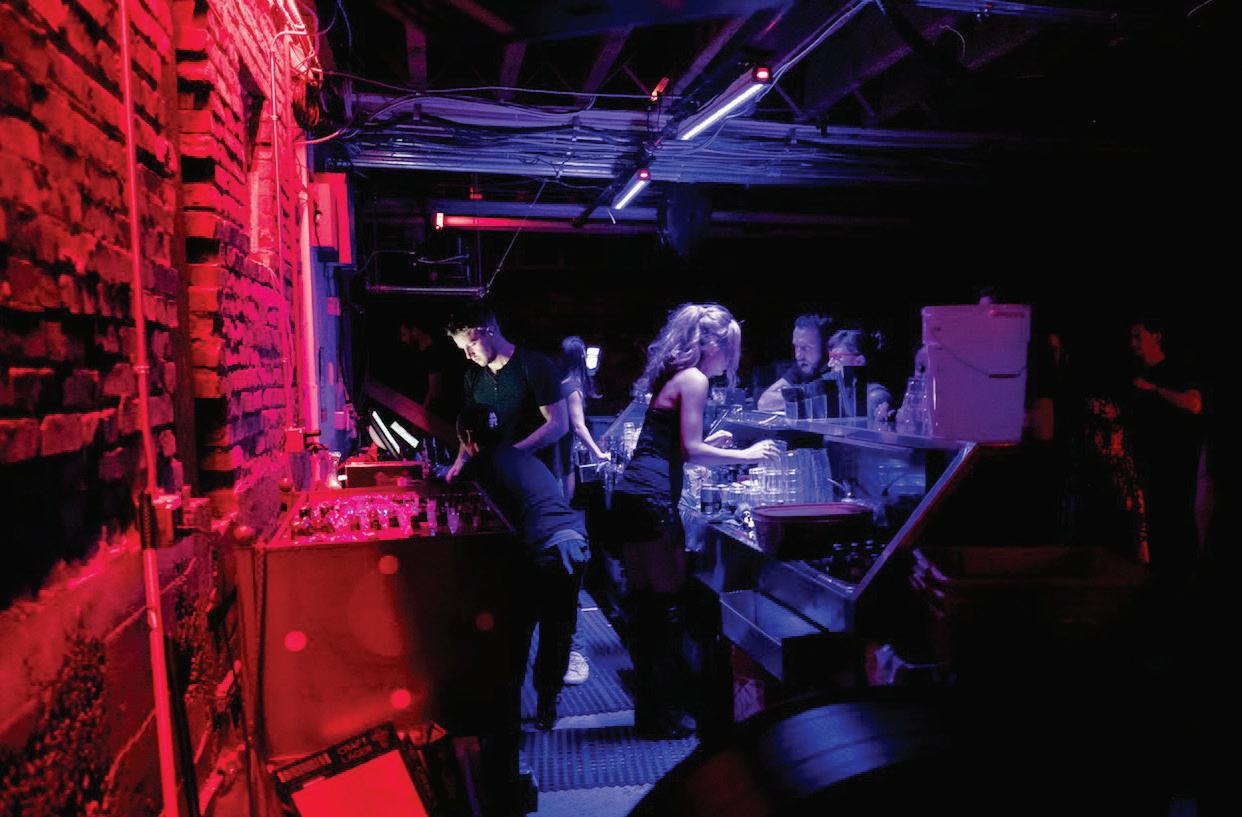
First-year kinesiology student
Frederick ‘Fre’ Solo has always had a hard time staying grounded.
Since he was three years old, his life has been defined by one urge: to climb. Now, he’s set his sights on what he says is the most death-de fying stunt on campus: scaling the Aviary.
Growing up on the flat plains of Saskatchewan, Solo had few outlets for his desire to ascend. He started with sitting on Daddy’s shoulders and climbing to the tippy-top of the slide before going down it again. The literal high was addictive. He hasn’t stopped chasing it since.
Moving to Vancouver has been a dream come true for Solo, although the ups and downs of the city took some adjusting.
“The first time I walked up a hill, from Alma up 10th Ave, I was in awe,” said Solo. “My calves were cramping, but I was completely in my element. As soon as I saw that view from the top, I was hooked.
The possibility of falling was just the last thing on my mind.”
Since then, Solo has dedicated 20 hours a day to training, including a rigorous regimen of lifting a q-tip on his pointer finger like it’s a dumbbell.
“It’s a mental sport more than a physical one,” said Solo. “It’s all
“The possibility of falling was the last thing on my mind.”
about understanding the climb so well that you can do it instinctively.”
“So I actually spend most of that time just rotating tall things in my mind: like stairs, or trees, or Ava Michelle from the movie Tall Girl (2019).”
His hard work paid off when he successfully summited the Wreck Beach stairs and Buchanan Tower.
“BuTo was a big step for me, in terms of elevation,” said Solo. “I did end up using the elevator for the final floors, but I had never been that high above sea level before. It
Fourth, make an excuse: There was exhilarating.”
He also has attempted less or thodox climbs on campus, including the Life Building construction site.
“Trying to scale the crane, espe cially during broad daylight, was a misstep, and they did bounce me,” said Solo.
He was thwarted, but he is trying, as always, to “take the high road.”
Although many don’t understand his freakish urge to take death-defy ing risks, he has also drawn a small but inspired following of climbers
on campus.
“I first noticed Solo during the end of his BuTo climb,” said avid UBC boulderer Gil ‘Rock Lobster’ Wall. “The way he gastoned that undercling — in layman’s terms, to press the little circle formation on the wall — was like nothing I’ve ever seen before. He just jammied into that weird box and shot straight up!”
Solo’s girlfriend Gina Hueco, a third-year sports psychology major, supports his ambitions completely.
“In the three weeks we’ve been
dating, I’ve grown to really under stand him,” said Hueco. “It’s like an almost psychosexual urge, his compulsion to climb no matter the risk. I think he’s missing the part of his brain that feels fear.”
“Of course I get scared for him,” she added. “These three weeks have been the deepest and most im portant relationship of my life, and I would be devastated if anything were to happen to him. But, his dream is to put himself in increas ingly death-defying situations, and I can’t get between him and his dreams.”
Solo has turned his sights on one of the riskiest climbs on cam pus, and some say, the world: The Aviary, UBC’s own “climbing wall.”
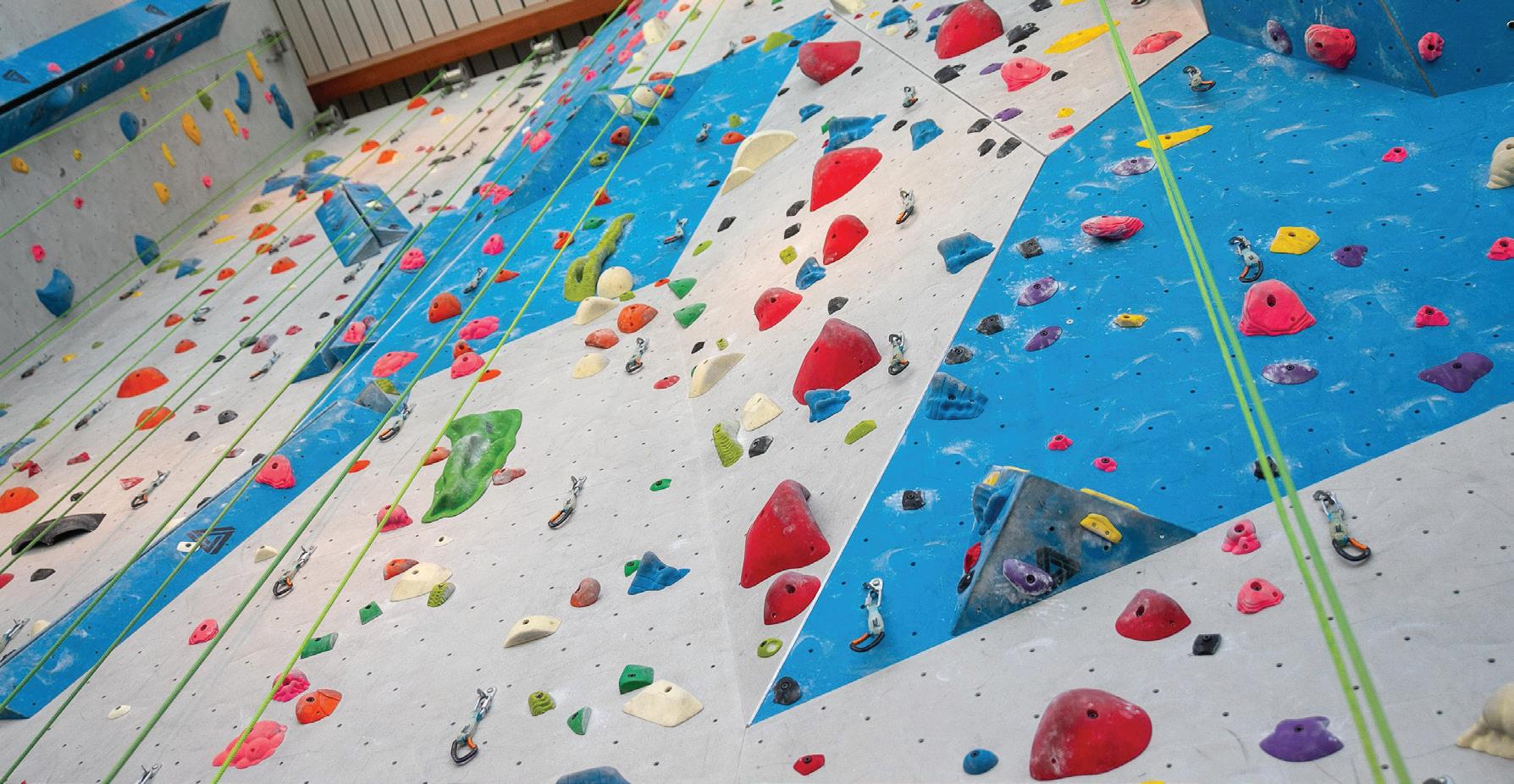
“It has never been successfully attempted,” said Solo, “But I really believe I was born for this. I will send this highball onsight and top out — or die trying.”
“The Aviary has actually been climbed, many times,” said Aviary lead boulderer Granola ‘Climber? I hardly know ‘er!’ Matryoshka. “And nobody is allowed to climb it without a safety harness. Not sure where the lil guy got that idea from. But he’s a real trooper, with great potential — we don’t want to dim his sparkle.” U
The Dingbat is The Ubyssey’s hu mour section. Send pitches and com pleted pitches to blog@ubyssey.ca
It’s the start of the school year, and that means upper-year stu dents are wondering what they’ve achieved and second-years are wondering what they’d like to achieve as they choose majors.
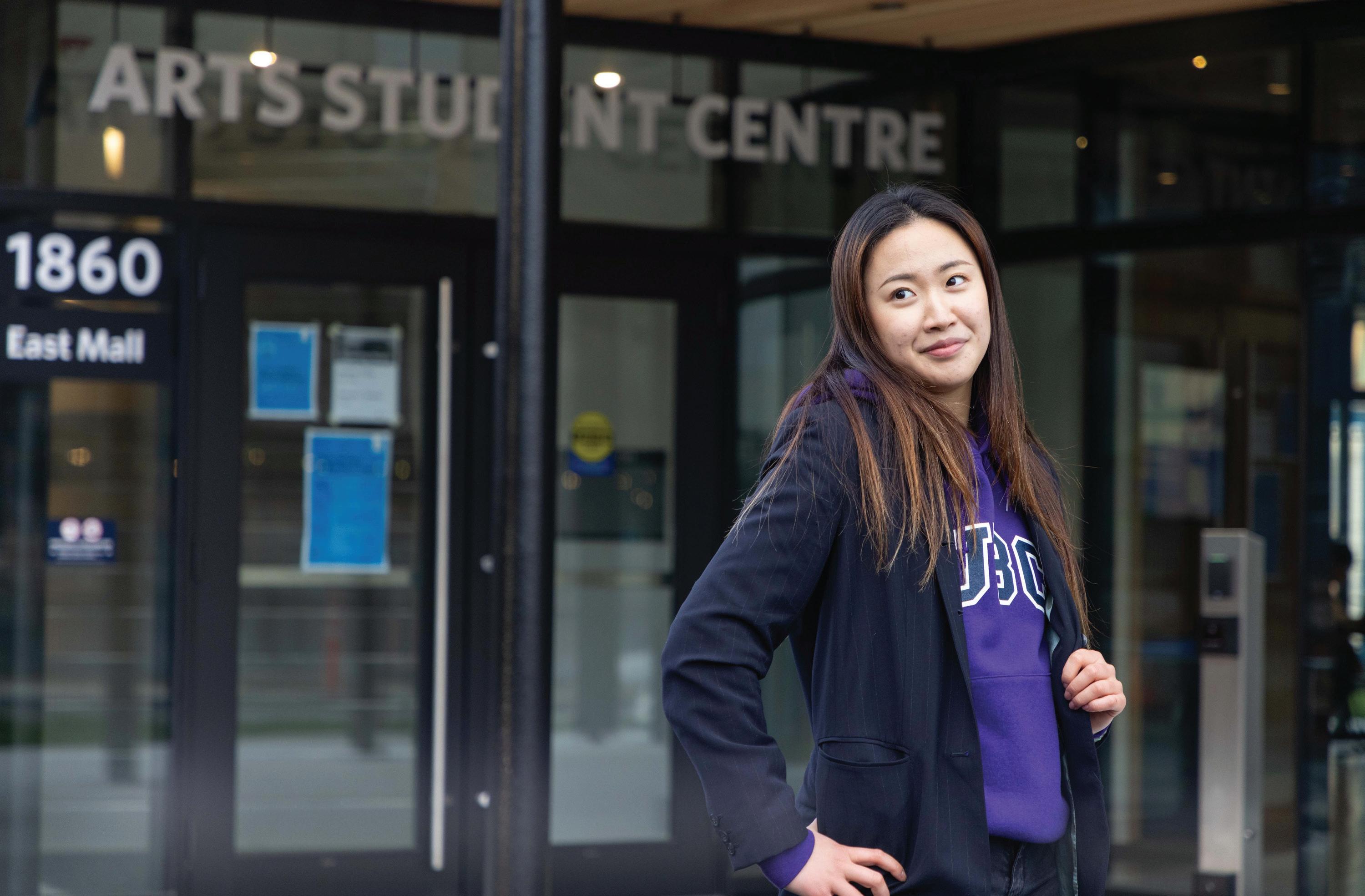
In the Faculty of Arts, both groups are tainted by the stigma and misconceptions associated with the beleaguered arts degree: pointless, easy and a bad bet in an increasingly competitive economy. Unlike my friends in engineering and science, my decision to pursue history and French usually pro vokes more skepticism than com pliments. Such negative attitudes are endemic and many arts majors end up internalizing them.
Yet, they’re wrong. The hu manities and social sciences (AKA the liberal arts), and the people who study them, are valuable and, indeed, critical in today’s world. In other words, a BA really isn’t BS.
The classic misconception about arts majors is that they end up sad and jobless. And while sometimes that outcome is beyond our con trol — the job market is tight and full of gatekeeping — the above is still an easily disprovable myth.
Just look at all the BA grads who occupy important positions in our local, national and global communities. UBC BA grads have, and continue to have, meaningful
careers in fields like politics, edu cation and journalism.
Outgoing UBC President and Vice-Chancellor Santa Ono graduated with a BA and credits it for making him a better scien tist and educator. Likewise, BC Premier John Horgan and Health Minister Adrian Dix — both of whom have been critical in BC’s pandemic response — are both history grads. And Prime Minister Justin Trudeau earned his English literature degree at McGill (before getting his education degree at UBC). In fact, every single Cana dian prime minister, besides those who went straight into lawyering or politicking, had a BA under their belts.
It’s not just in politics that we see big-ticket BA holders, either. Countless acclaimed authors, like Margaret Atwood and John Green, also studied the humanities at uni versity. And, according to Forbes, the BA is one of the most popular degrees among Fortune 500 CEOs, including former Starbucks CEO Kevin Johnson, interim Starbucks CEO Howard Schultz and Susan Wojcicki, the CEO of YouTube (who also helped found Google).
To put it simply, arts grads run much of the world.
Lots of these successful BA grads say their undergraduate training set them up for success. Far from being easy and self-in dulgent, the arts is a challenging discipline and its students acquire crucial skills and knowledge about the world from their degree.
These students read hundreds of pages of ground-breaking scholastic and cultural work every week. They engage with — and challenge — some of the most important issues and ideas in hu man history. They’re trained not to accept or expect easy answers and they study debates over issues over which the smartest people have disagreed. Then they have to assemble their own ideas into in sightful essays that their profs can then tear to shreds, telling them to do better next time. Then they do just that.
Despite knowing that humanities students do in fact have arduous work at post-secondary institu tions and end up in important, fulfilling jobs, many still wonder if the arts and social sciences are of any real value to the world. The answer is an emphatic yes.
Whether one is studying New Wave cinema, democracy or Indigenous literature, the arts specializes in producing critical thinkers, which has never been more important to the world.
In many areas covered in the liberal arts, such as questions about ideal governments, literary style and historical interpretation, there really is no ‘right answer.’
Such lack of clean-cut, definitive answers means arts majors are required to think open-mindedly about abstract concepts, differing
viewpoints and their own beliefs to formulate nuanced arguments and defend their positions.
Arts students are thus trained to sniff out places where assump tions and ideology shape inter pretation and lead to the scourge of misinformation. Although BA students and grads don’t have a monopoly on that — scientists and doctors are vital in combating anti-vaccination ideas, for instance — they can be especially equipped for it.
With their emphasis on writing and different forms of communi cation, the liberal arts also create clear and creative communicators.
According to Dr. Raúl Álvarez Moreno, a UBC associate professor of Spanish, the humanistic story telling and debate skills developed in humanities classes give people the skills to find common ground. And all those thesis-driven essays might be exhausting to write, but they train students to be better at persuading people — vital both for the job market, and for creating the connections necessary to build consensus around the issues that matter.
The world is diverse and complex, and arts grads who’ve gained valuable cultural perspec tive are very well positioned, and indeed vital, to tackle racism, reduce global conflict and foster peace. The long reading lists of humanities courses aren’t just padding, and arts curricula don’t just read dead white guys anymore: lots of understanding
comes from reading texts from outside ubiquitous, Western per spectives. While identifying his torical, social or political contexts behind poverty and anti-Black or anti-Asian racism doesn’t mag ically solve such problems, it’s key to beginning to combat them. How can we begin to solve issues if we don’t understand how they began?
And, although it is undoubt edly true the STEM fields will be essential in tackling global crises like the climate crisis and pan demics, so too will the humanities. The global issues we face today are not only medical or environ mental; they are human problems.
As Ono said in a 2019 talk about the humanities, “we need the liberal arts to help make sense of our world — as we grapple with issues like climate change [... and] hatred and prejudice [...] the humanities can give us the critical thinking skills and the perspective to deal with these issues.”
In the end, the value of the humanities and social sciences cannot be overstated. Far from just making latte art, BA grads will leave university with an invalu able, world-changing degree they can be proud of. U
Shane Atienza is a senior-year stu dent studying history and French. His research interests include Canadian constitutional and legal history. Shane has also contributed to The Ubyssey
A UBC research team has devel oped copper-coated technology to kill bacteria — perfect for use in hospitals, campuses or even on your phone case.
This past spring, UBC materials engineering professor Dr. Amanda Clifford partnered with mining company Teck Materials to install adhesive copper patches in nine UBC Applied Science buildings. The patches take advantage of copper’s inherent anti-microbial properties, killing over 99 per cent of bacteria within hours of contact.
In parallel, Clifford’s lab at UBC was working on an even more potent project that halves the amount of time it takes to kill thick-walled, or gram-positive, bacteria.
The team’s engineered copper coating is reinforced with na no-bumps that rupture bacterial cell walls. It also combines copper with zinc, another antibacterial element that can kill bacteria more quickly than either element alone.
In July, Clifford and colleagues published their findings in Ad vanced Materials Interfaces and filed a provisional patent for the coating.
of fabrication as a “low-cost and scalable route” with potential for widespread adoption.
said.
Reported case fatality rates for C. difficile infections have ranged from 6 to 30 per cent. The UBC researchers’ copper-based attachment could prevent patients in hospitals from contracting these types of infections.
The engineered copper could also target the harmful evolution of bacteria, viruses and fungi, also known as antimicrobial resistance.
During an infection, microbes which are resistant to the body’s immune defences and medical treatments survive and reproduce. During this process, the resulting population can become more con tagious, more deadly and harder to kill.
“We’re going to be in a very bad position globally if pathogens … or bacteria continue to become resis tant to antibiotics,” she said.
In the future, the UBC re searchers plan on bringing the coating to the commercial market: their paper describes the process Michael Vento Contributor
Their copper-based material was formulated with ease of use in mind since the coatings can be glued onto existing surfaces. Clifford even has a copper patch adhered to the back of her phone.
Now that her team’s exper
imental design has been tested with anti-bacterial properties, they are moving to test the coat ing’s anti-viral potential. This will hopefully expand the scope of the material’s usefulness, as Clifford and her team continue to test and optimize their engineered copper.
see how our material works,” said Clifford.
Clifford’s team plans on placing the engineered coating in hospital settings to combat the spread of viruses.
The traditional solution to evolving pathogens, Clifford ex plained, is to continue generating new antibiotics that target new generations of harmful microbes. Installing surfaces that kill bacte ria immediately is one novel way to prevent microbial populations from evolving at all.
Gram-positive bacteria, like the colon-infecting Clostridioides difficile, are “a major source of in fection within hospitals,” Clifford
From guardrails to faucets, doorknobs and even stethoscopes, this UBC team-led copper coating has the potential to kill bacteria on many of the most highly-traf ficked surfaces within a hospital to radically reduce human contact with germs. U
An initiative started by UBC students is aiming to clear up the stigma of acne.
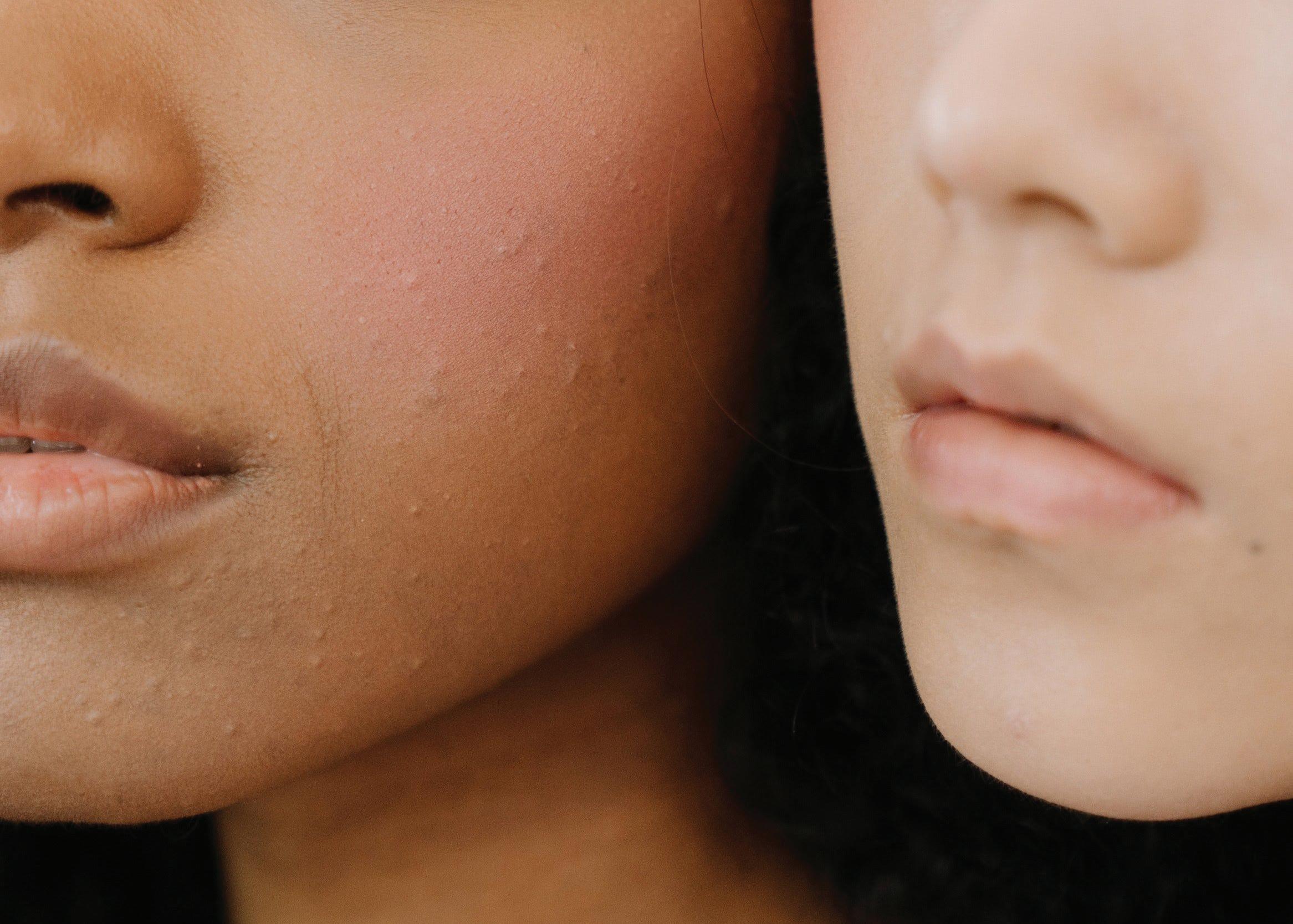
The Acne Education Project is a collaborative initiative between undergraduate and medical students at UBC. Founded in late 2020, they aim to raise awareness about the mental health impacts of acne and support evidence-based workshops to educate youth in “a fun and engaging way,” according to its website.
Vincent Wan, the co-founder and president of the Acne Educa tion Project and a doctor of medi cine candidate at UBC, said he and his co-founders initiated the project to increase education about the physical and psychological aspects of acne vulgaris.
The project started out as an “ev idence-based workshop” targeted at elementary school classes, said Wan. After launching, the Acne Education Project garnered the attention of a local dermatology resident, who connected the project leaders with three local Canadian dermatologists who reviewed their presentation.
This year, the Acne Education Project delivers free educational presentations to elementary and middle schools from grades five to eight across BC.
“We’ve been able to present to over 40 different schools so far,” Wan said.
The project preaches three aspects within its presentation: pre vention, management and reaching out.
According to Wan, developing a skin care routine can help in the prevention of inflammatory, come donal and nodular cystic acne.
“Having a good and consistent skincare routine can help prevent or combat these [types of acne],” he said, “but it’s important to be gentle.”
He also mentioned balance. “Exercising, having good hygiene, changing masks and pillowcases. These are all different things we can
“Copper has been registered as antiviral metal, but we want to touch on in terms of prevention.”
When discussing acne man agement, Wan said many overthe-counter options are available. Through the project, he’s learned many youths are not aware of certain effective — and affordable — medications such as salicylic acid or benzoyl peroxide. He mentioned oral isotretinoin as a prescribed medication that can help control acne.
Wan mentioned the common
ality of highly-reviewed and effec tive medications, such as Retin A, which are relatively inexpensive.
“Some of the Retin A tubes are 20 dollars and can last you over the year,” Wan said.
He warned about the many but perhaps less effective alternatives available in pharmacies.
“When I was in high school, I was so desperate to find some thing that worked,” he said. “I put my own earnings into buying
products that I thought would help. In the long run, I ended up wasting a lot of money to try and fix my skin.”
Wan said the severity of acne can be subjective, but speaking to a doctor is important if it’s affect ing daily life.
A big part of the project is also addressing the negative stigma surrounding acne. A recently published study from the Journal of the American Academy of Dermatology found there to be a “significant association of acne vulgaris with depression.”
“Up to 90 per cent of students will experience acne at some point in their lives,” Wan said. “Yet we don’t really talk about it, ever. For any dermatological condition, there’s a stigma that it could be infectious or that someone with acne is dirty.”
The work of the Acne Educa tion Project is gaining traction, with members gaining recognition from the Canadian Dermatology Association. The project won the Public Education Award presented by the association in late July of this year.
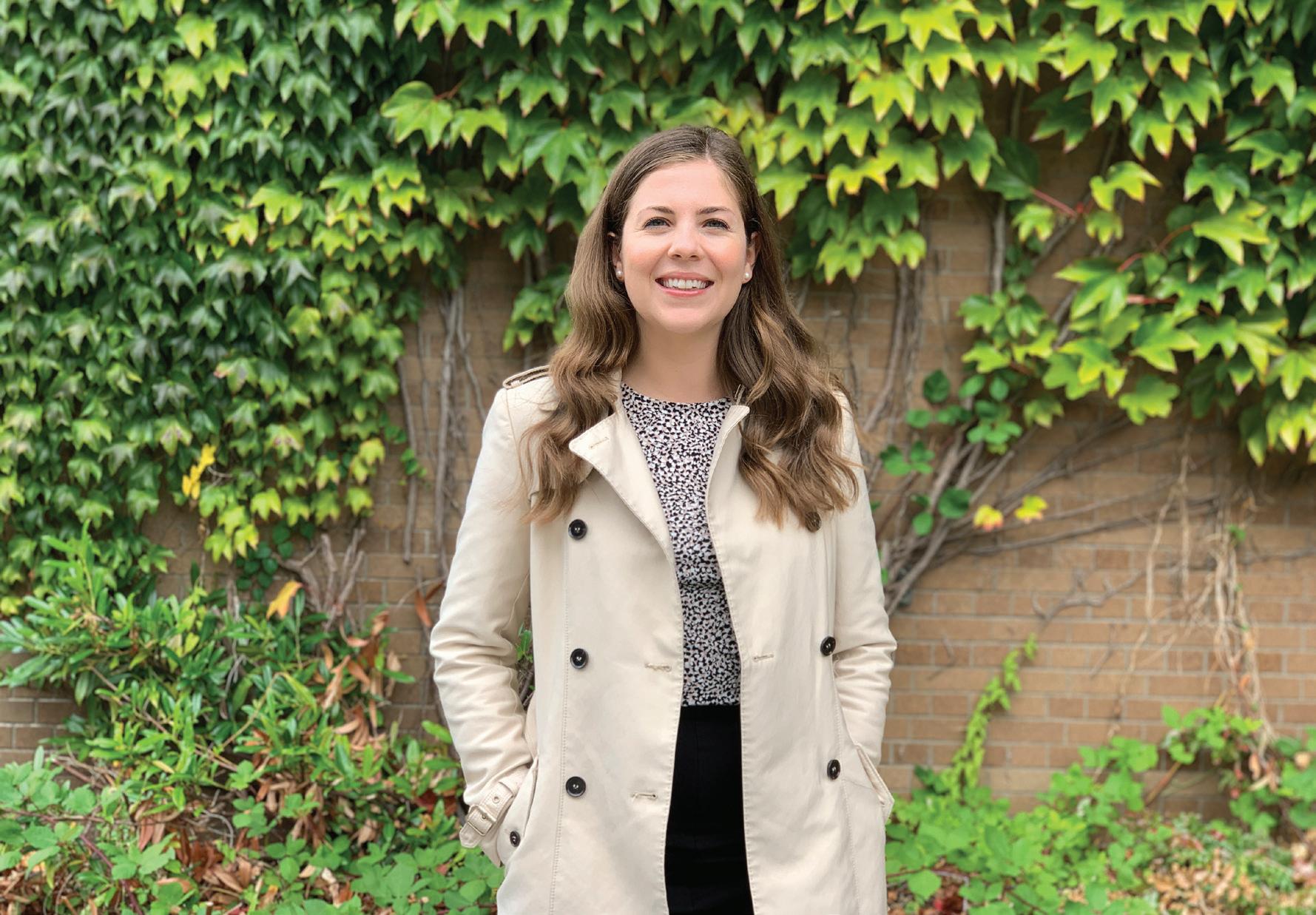
“We really hope to use this recognition to spearhead our next steps,” Wan said. He said the Acne Education Project is trying to ex pand across rural BC. Members of the project are currently looking at grants to expand its operations.
“Eventually we want to reach a stage where we can get in touch with the Minister of Education, possibly integrating a little bit of acne education in the elementary school-level.” U
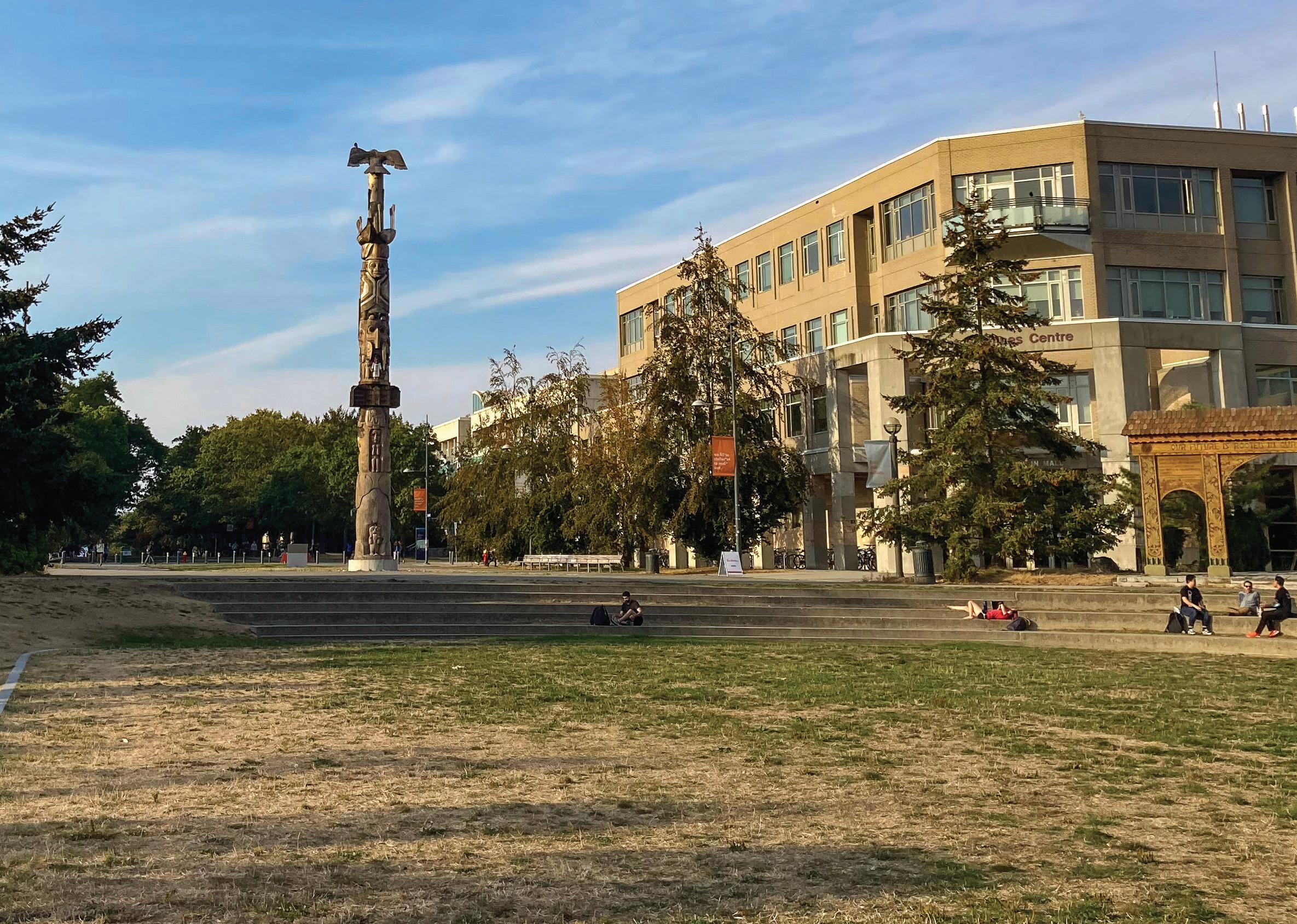 Shereen Lee Contributor
Shereen Lee Contributor
While some might find the Octo ber sun to be a welcome departure from Vancouver’s infamous rainy autumns, the unseasonably warm weather is raising alarms among some climate scientists.
On the morning of October 7, the BC government updated the Lower Mainland to Level 5 drought status, the peak of the province’s five-level scale.
This puts Vancouver in a con dition of “exceptional drought,” according to Agriculture Canada.
“It’s the continuation of a trend that’s very easy to see in the long term data,” said UBC forestry professor Dr. Peter Arcese. “That trend has gotten much deeper after about 1950, and in our local area, it’s gotten particularly steep since the 1970s.”
“So what we see is the general warming of summer temperatures and an increasing length and depth of drought.”
Environment and Climate Change Canada reported that early October weather broke nine community temperature records across BC. Metro Vancouver’s up coming weekly forecast is mostly sunny, with high temperatures of 20 degrees Celsius.
“The population keeps on growing, the demand for water
keeps on growing and the seasonal climate in our neck of the woods has a really sharp contrast,” said UBC earth and ocean sciences professor Dr. Sean Fleming. “It is extremely wet for much of the year, but we also have this really long drought period that can go from anywhere from July to Oc tober.”
According to Fleming, that ex tended dry period, combined with population growth and increased water demand, creates serious water stresses.
“This has been building for years, if not decades,” Fleming said.
As one mitigation strategy, Metro Vancouver has extended lawn watering regulations until October 31. Under the Drink ing Water Conservation Plan, residents and businesses are only allowed to water their lawns once a week until this period elapses.
While a press release from Metro Vancouver said reservoir levels are currently normal for this time of year, the province could be required to take more direct actions if the dry spell continues.
“It’s really time to start looking at the experiences and the exper iments and the successes of other parts of the world,” said Fleming. He cited Las Vegas’s permanent water policies as one example of effective climate policy.
Las Vegas implemented a num ber of incentives and policies for reducing water consumption, such as rebates for climate-friendly landscaping.
Arcese, who co-authored a 2020 publication on strategies for
increasing conservation financing, thinks that changes in climate poli cy should be considered thorough ly. Compensatory actions for the current drought such as restricting access to water or removing dams, he said, could lead to unintended
social or ecological consequences.
“My personal perspective as a scientist is that we need to find the things that suffer most because of the current conditions, and for which we have some method of improving things,” said Arcese. U
education, Nicol said these complex emotions contribute to their work’s importance.
“Thinking about patience and struggle, perseverance — those are all parts of what we want students to learn, and they’re all part of the competencies of the BC math cur riculum,” she said.
Rather than relying only on text books and worksheets, the Indig enous Mathematics K12 Network allows a platform for educators to connect, brainstorm and share their work with colleagues, particular ly through the Network’s annual symposium.
Educators in the network focus on outdoor and place-based learn ing. Hands-on activities are also integrated, such as a beading project where students create beaded hy persquares and discussed principles of math and story.
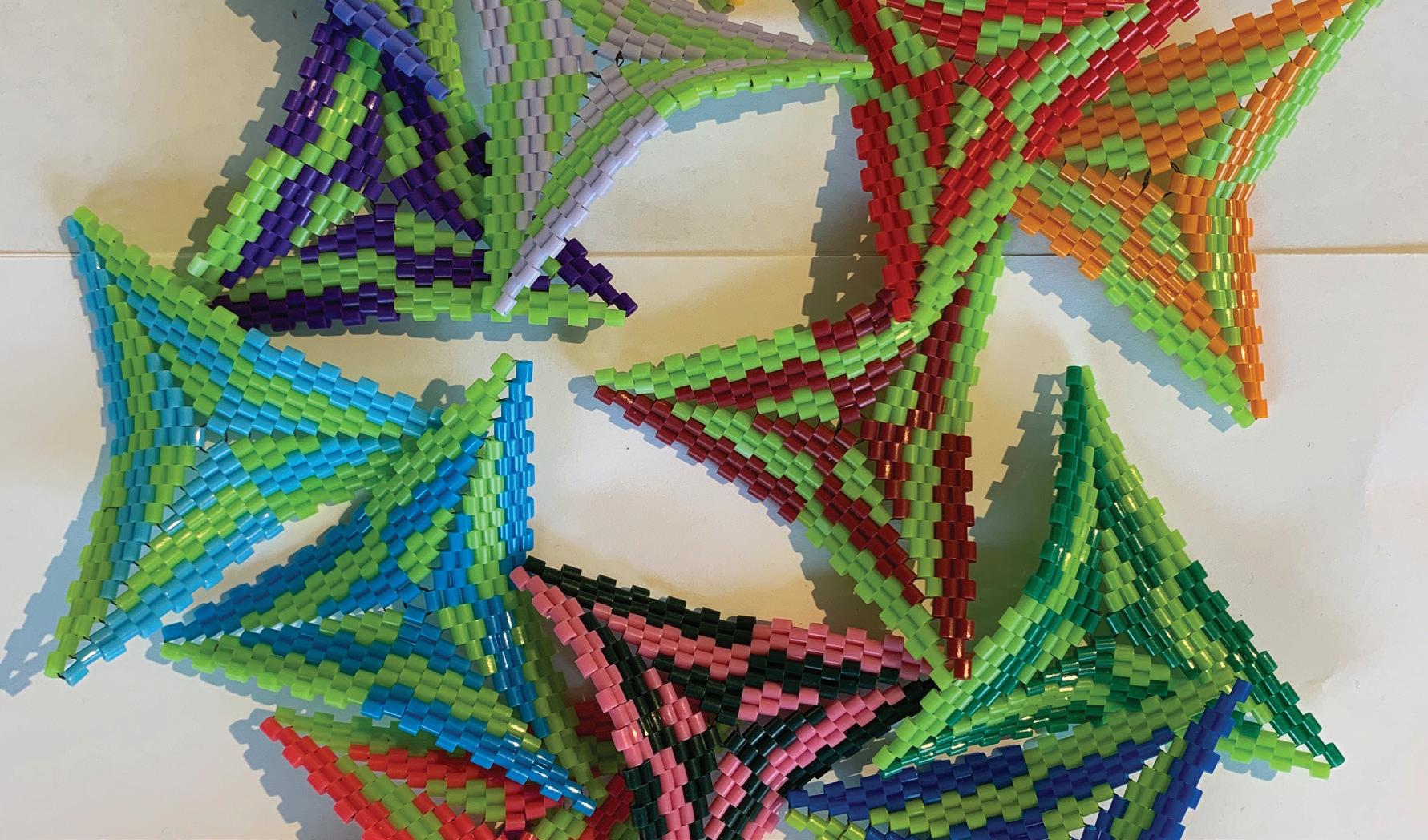
highly successful based on educator feedback, with some students even wondering whether what they are learning is “really math.”
Archibald said the teachings explored in the Network, including “learning the cultural background ... and establishing relationships with Indigenous community members or cultural knowledge-holders,” are broadly applicable beyond math.
She encouraged teachers to reach out to Indigenous support staff whose roles include facilitating instructors “with cultural resources or cultural approaches” to create an engaging and culturally-aware environment across disciplines.
An initiative spearheaded by UBC educators unites Indigenous expe rience with the foundations of math education.
Dr. Cynthia Nicol, who holds the David F. Robitaille professorship in mathematics and science education, and Dr. Jo-ann (Q’um Q’um Xiiem) Archibald, a former associate dean of Indigenous education, spent over a decade developing UBC’s Indig enous Mathematics K12 Network.
The project unites Indigenous perspectives, culture and mathe matics education to illuminate the possibilities and the practical uses of math.
While teaching on Haida Gwaii, Nicol noticed Indigenous students could experience a sense of alienation from traditional math ed ucation, which often incorporated problems that lacked grounding “in what was important to the ... kids and families who were living there.”
The Indigenous Mathematics K12 Network aims to combat such
alienation by considering math education alongside principles of Indigenous story work. In her book Indigenous Storywork: Educating the Heart, Mind, Body, and Spirit, Archibald outlines seven core principles: respect, reverence, responsibility, reciprocity, synergy, interrelatedness and holism. Archibald said incorporating these principles allows students to remain “excited and interested” in math.
While Archibald and Nicol acknowledged the challenges and frustrations that can arise in math
“We had mathematicians, we had teachers, we had kindergarten teachers, we had just a real range of people talking about what they were noticing, what they were thinking, not just about mathematics, but how to be in relationship to story,” said Nicol.
The Network educators frame math in a way that allows students to understand the connections be tween math and their own lives and communities. This might include using math to make sense of current issues, such as climate change, dis placement and reconciliation.
According to Archibald, the Network’s techniques have been
Moving forward, the Network has several projects underway, including providing small-seed funding for educator projects, de veloping a webinar series on cultur ally-responsive math assessments, and the expansion of a mentorship pilot project currently underway in multiple school districts across the province.
Ultimately, Archibald and Nicol hope the Network can allow students to “enjoy math and [be] challenged by it.”
According to Nicol, mathematics allows students to engage in our natural instinct to seek patterns in the world, exemplified by the fact that “every culture has mathematics in some way.”
For her, math is not only a school subject, but with willing and engaged educators, a “language to express what it is we see.” U
Fifth-year forward Danielle Steer tallied twice this weekend in Vic toria to power UBC to a 2–1 victory. The match remained scoreless af ter a slow opening half. University of Victoria Vikes’s Sophie Murphy got the first of the game in the 51st minute off a UBC turnover. Seven minutes later, Steer matched the Vikes’s score on a Katalin Tolnai assist. UBC’s second goal came in the 59th minute when Steer’s head found a Jaqueline Tyrer corner kick. Steer’s two second-half goals tied her at 65 with UBC alumnus Jasmin Dhanda for all-time Canada West points. Two regular season matches remain for Steer to move into the undisputed lead. U
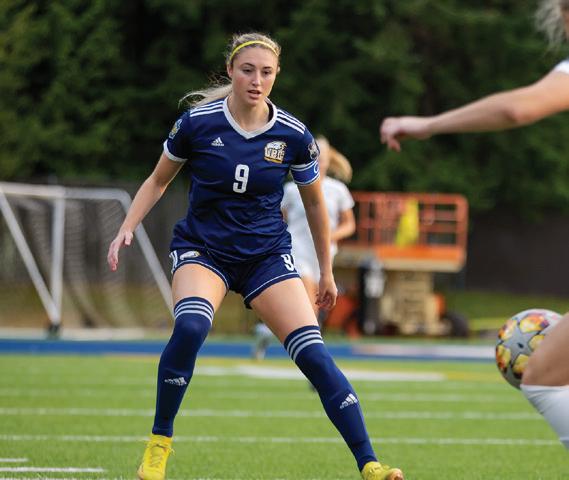
UBC men’s soccer improved to 6–3–2 in Canada West play after a 1–1 road draw and a 7–2 home win in their doubleheader this weekend against the University of Victoria Vikes (2–6–4). On Saturday at home, the T-Birds ran rampant out of the gate, scoring three goals inside eight minutes to take control of the match. Logan Chung and Markus Puhalj both added to UBC’s tally before the half. Connor Mrazek made it 6–0 in the 47th minute, before UVic got two goals back. In stoppage time, Asvin Chauhan’s through ball found Tristan Nkoghe, who finished em phatically for the T-Birds’s seventh goal. U

UBC women’s hockey left the Uni versity of Manitoba Bisons with no room to breathe this weekend, scor ing a 6–1 victory that was immediate ly followed up by a 6–2 win. Friday night’s game opened with a banner raising ceremony to celebrate the Canada West 2021/22 championship. A three-goal third period saw Joelle Fiala score early and Cassidy Rhodes net two goals on top of her goal from the second period for her first U SPORTS hat-trick. On Saturday, five T-Birds added to the scoreboard to push UBC past the Bisons in an eventful first two periods. “This was our first week back in the Doug and you can see the excitement,” said head coach Graham Thomas. U
Over the weekend the UBC Thun derbirds men’s hockey team headed to Winnipeg to face off against the University of Manitoba Bisons. The T-Birds had immense offensive prowess, scoring 14 goals in the weekend series, and improving to 3–0–1 on the season. Friday night’s game was tied at 3–3 with under 10 minutes to play. UBC and Manitoba exchanged goals to make it 4–4. With just over five minutes left, firstyear T-Birds forward Josh Williams scored the game-winning goal and the first of his Canada West career, and UBC went on to win 6–4. On Saturday, Cyle McNabb completed a hat-trick, powering the ‘Birds to a 8–7 win. U
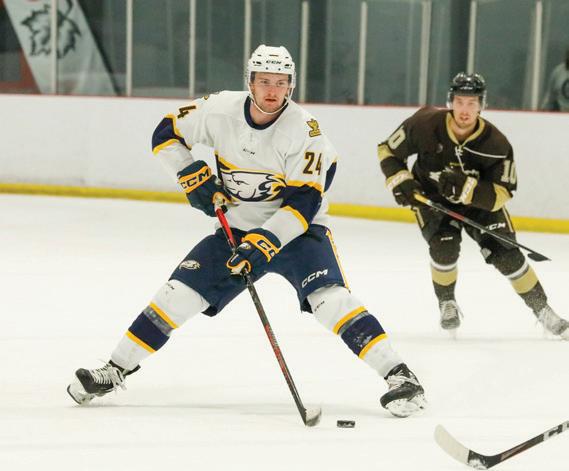

experience because of the scale of events the mostly-volunteer team is able to pull off. The Day of the LongBoat is the world’s largest voyageur canoe race. “It’s unique to get to experience that while you’re still in your undergrad or your grad.”
Among the many student vol unteers were also several alumni. As the first teams of participants startly slowly checking in at the event, I had the chance to speak with one of the event’s MCs through the loud 8 a.m. tunes.
On the balcony of the Sailing Centre overlooking the start beach stood a very energetic UBC alum, Katrina Del Rosario, with a microphone in her hand and a smile on her face. She told me, “The energy comes from the sun, from the awesome weather and it comes from people and students like you.”
soon as I asked my first question, Northey had to leave to assist a team that had unceremoniously capsized.
Five minutes later, the boat had been turned upright and Northey was back to continue the interview. He told me that the event was running with a staff of 100 people, most of whom were student volunteers.
“They see that they want to be a part of something and that they really get ownership over something. They get to own an area and they get to execute on it,” he said.
In the months leading up to the event, UBC Rec’s usual canoe rental company lost all its equip ment in a fire. “We had to go on a search far and wide, that went from Fort Langley to Kamloops to Whistler, and search for voyageur canoes.”
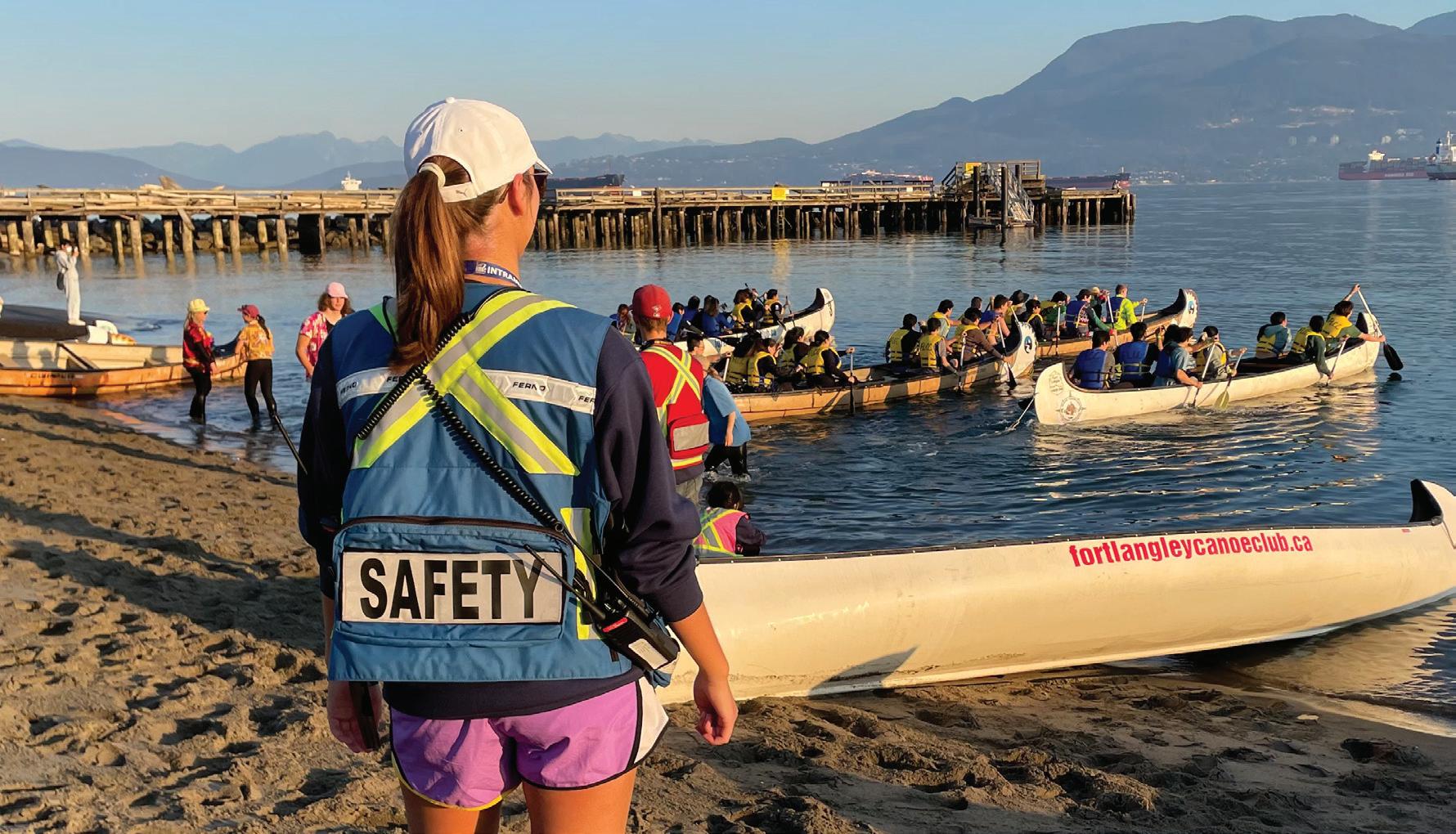
“They see that they want to be a part
Miriam Celebiler Sports+Rec EditorI watched the sun rise behind Vancouver’s skyline as student vol unteers in wetsuits and Hawaiian shirts pulled voyageur canoes into the icy morning water. Some had been at the Jericho Sailing Centre since 3 a.m., and by the time I arrived at 6:30 a.m., the shores were smattered with volunteers wearing the iconic intramurals jackets. There were still two hours left until the first participants would arrive for the Day of the LongBoat.
The Day of the LongBoat is a UBC tradition organized by UBC Recreation’s Intramurals program.
Canoe teams of eight to ten stu dents race around a set of buoys
to retrieve a baton and return it to the beach. The race ends when a member of the team bangs a gong with their retrieved baton. In to tal, students spend around an hour at the event; they check in, race, take some photos, enjoy the music and leave. However, for the vol unteers, the Day of the LongBoat requires months of work to bring the tradition to life.
Walking around the setup on the beach, I met one of the event’s student directors, Caroll Gao. Gao said she led a team of six assistant directors along with her co-direc tor Gabriella Guerra who had her own team of six. When I asked for an interview, she radioed Guerra. They weren’t sure how much time they would have once the event started, so we spoke right away.
Gao and Guerra said they had been planning the event since the middle of the summer. They estimated that throughout the process they had spent around 85 volunteer hours. Guerra explained the feeling of waking up at 2 a.m. for the day she had been working toward for over a month.
“You wake up with a lot of excitement, a little bit of nerves,” she said.
Guerra got involved with intramurals in 2020 when school was online. “I guess after COVID[-19] I recognized the need in the student body to have events like this that brought back school spirit and just having fun with your friends.”
Gao said volunteering for UBC Rec Intramurals is a rare
The first team of the day walked in with matching cos tumes. “We need our tutus and tiaras to help us seize the day,” said the group of first years com peting in their first ever Day of the LongBoat.
Twenty minutes later, the ca noes were off. As team after team completed the race and banged the gong, I saw volunteers work ing from the registration tents all the way to the finish line and every single one looked genuinely happy to be there.
At around 9 a.m., I planned to get an interview with the event’s overseeing director and UBC Rec full-time Intramural Event Co ordinator Alex Northey. I found Northey on the beach and took a few steps away from the com motion to have a quick chat. As
Voyageur canoes are a specific large type of canoe that are rare to find. When the team was able to pull together 11 canoes to make this Day of the LongBoat happen, it made this year’s event even more special.
Throughout the day there was paddling, dancing, laughter and the occasional capsize. Quietly uniting this whole event were the 100 enthusiastic volunteers without whom none of this would be possible.
“When you’re wearing the [Intramural] jacket around campus, you can see people feel comfortable to come and talk to you and you can help them out in any which way,” said Assistant Di rector of Staffing and fourth-year student Sammy Wilhelm. “We say it’s the power of the jacket.” U
